DAY 1
Since this day materialized unexpectedly and was actually a “non‑working” one, its description is a preamble story of all the twists and misadventures that preceded the trip. I had wanted to return to Germany for a long time. I traveled a lot around it in the ’90s – south, west, east, and north – but when, out of sheеr curiosity, I decided to see how many days I’d need to “cover” this country properly, I arrived at the number 47. So I had to split it into three legs. And now I’m finally doing the first of them: Lake Königssee, a transfer to the Garmisch‑Partenkirchen area via Austria, three days there with hikes and nature outings and then driving on to Frankfurt, mostly through half‑timbered towns.
I had booked tickets in February but when it came closer to to the departure day, the situation in the country became tense, and my flight was cancelled. My hands dropped in despair, but my travel companion cut off my defeatist tendencies and found a replacement in the form of three separate flights: outbound via Athens, with an overnight, and a direct flight back one day later then planned. It even came out €55 cheaper (assuming a full refund), but that saving was more than eaten up by the need to book two extra hotels with transfers.
And so I’m flying, with a half‑hour delay. I dozed a little, making up for the fatigue of the last hectic day. Below, countless Greek islands and islets are gliding by. There’s one that looks like a lobster with the hind legs of a rodent, with a village nestled between its claws. Strange to see a village on an islet which, like many others here, seem, from above, unfit for living. When I realized I should make a photo of it, it was too late. I shot another one so I’d have at least something.

Landing, transfer. A perfectly acceptable overnight stay with air‑conditioning, 15 minutes away, €49 per person, €20 transfer. The (female) driver even, puffing, hauled my suitcase up to the second floor. A kettle, tea, and a toaster that warmed the pita with cheese I’d brought from home. All right, report filed I need a little sleep; tomorrow the alarm is at 5:45. Wishing everyone flights without cancellations.
DAY 2
On the way to the airport I pestered the driver with questions about the Greek language, while also telling her why “bank” in Greek is called “trapeza,” figuring out for myself that “trapeza” was originally just a bench on which people sat to eat (and our word “bank” comes from the Italian “banca” the bench on which money changers, the predecessors of bankers, sat in the streets).
At the airport there were three little episodes illustrating the efficiency of its staff. Not trusting my phone, I printed my boarding pass and then lost it. Above the check-in counters there was a sign: “Boarding pass required.” Not having one, I turned to a supervisor, who sent me to a completely inappropriate place. Returning, I passed check-in without any trouble. Handing me the boarding pass, the agent instructed me: “Boarding starts at eight minutes past four.” (The flight was at 8:35.) I said, “Maybe five past eight?” “Yes,” he replied. “7:55.”
In the departure lounge, I decided to have some coffee and ordered an espresso. The barista enquired how sweet I wanted my coffee and, to my surprise, handed it to me in a tall glass and at the lofty price of 4.80. After a sip I understood: he’d made me an iced coffee. I asked for a replacement, which was done without issue, and the price dropped to a normal 1.90. True, I didn’t get the 10 cents in change; apparently they decided to compensate themselves for the extra effort. The coffee was excellent, shaking my confidence in the supposed superiority of Italian or Portuguese coffee.
Boarding time. Mustering my extremely modest, few-word-supply of Greek, I said “Kaliméra” to the greeting flight attendants. Last row, no recline. Well, if you don’t want to pay, be content with what you get. We took off. Soon the tempting aroma of baked goods and coffee drifted through the cabin. They offered a choice of an omelet sandwich or something sweet. I chose the latter, which turned out to be anything but sweet. Coffee and drinks – all you want.
I recalled how cleverly an airline I once flew from La Paz, Bolivia, to Chile avoided feeding passengers. A five-hour flight, you suppose to have a meal. The Chileans devised a peculiar way to enter the country by air: they conduct customs and passport control at an airfield in the Atacama Desert shortly after crossing the border. After takeoff from for thr rest of the flightthere I waited in vain for sustenance that never came. When asked why, the flight attendant replied that it was already a domestic flight, and meals aren’t served on domestic routes.
At that same desert airport I encountered an example of empathy and solidarity, unusual for such places. I had in my carry-on a souvenir, “la cabeza” (“the head”), a face drawn on a dry, hard fruit with seeds rattling inside. The customs officer said seeds were prohibited. My attempts to convince him saying that they had long dried out, were dead and couldn’t sprout, and that it was a pity to throw away such a charming souvenir, were rejected but he suggested making a hole and shaking out the seeds, to which I gladly agreed. He took out a small knife, performed the procedure, and returned to me a now “kosher” souvenir. All this time the plane was waiting for me, the last missing passenger. Unique.
Having written these lines, I looked at the watch. Horror! We’re late; the car is at risk. Having completely exhausted my Greek, I said to the flight attendants: “Efcharistó” (from now on it’s just “Guten Morgen” and “Danke schön”), and rushed out of the plane. Upon entering the terminal and glancing at the clock I get a clear confirmation of my creeping dementia: I’d forgotten about the time difference. The plane not only hadn’t fallen behind; it made up the 10-minute delay and even landed ten minutes early.
And here we are, sitting in our luxurious new limousine and setting off. The navigator, after leading us onto some side roads, fell silent. Without its verbal help, driving became very difficult, and we spent about two and a half hours getting to Lake Chiemsee instead of the promised hour and a half.
The little town of Gstadt am Chiemsee turned out to be quiet and a bit sleepy, and the views of the lake and the mountains beyond inspired peace and tranquility. But the body demanded fuel, and we set out to find a restaurant, preferably on the shore. We found one and it turned out to be a Japanese restaurant called, naturally, “Lake View.” Could I ever imagine my first acquaintance with Japanese cuisine would happen in Germany and in the heartland, at that?
The food was quite decent. Then we went on a boat trip to see the sights. The first stop was Frauenchiemsee Island with the women’s monastery of the same name where we didn’t disembark for lack of time, and the second was Herrenchiemsee Island with the men’s monastery of the same name. But its main attraction is the summer residence of the King of Bavaria, Ludwig II, who spent almost the entire state treasury on building this and two other famous palaces Neuschwanstein and Linderhof.
We could have made the last 40-minute tour of the palace, an imitation of Versaille, but again decided not to: time was tight. I’ve seen the original and I hope the my companions will also see it some time. The palace stands in a beautiful forest-park setting. In front of it are three huge fountains: one is a copy of a fountain in Versailles, and the other two are copies of fountains in Spain’s royal palace of La Granja. The fountains are very beautiful, but their jets stop from time to time apparently to save water.
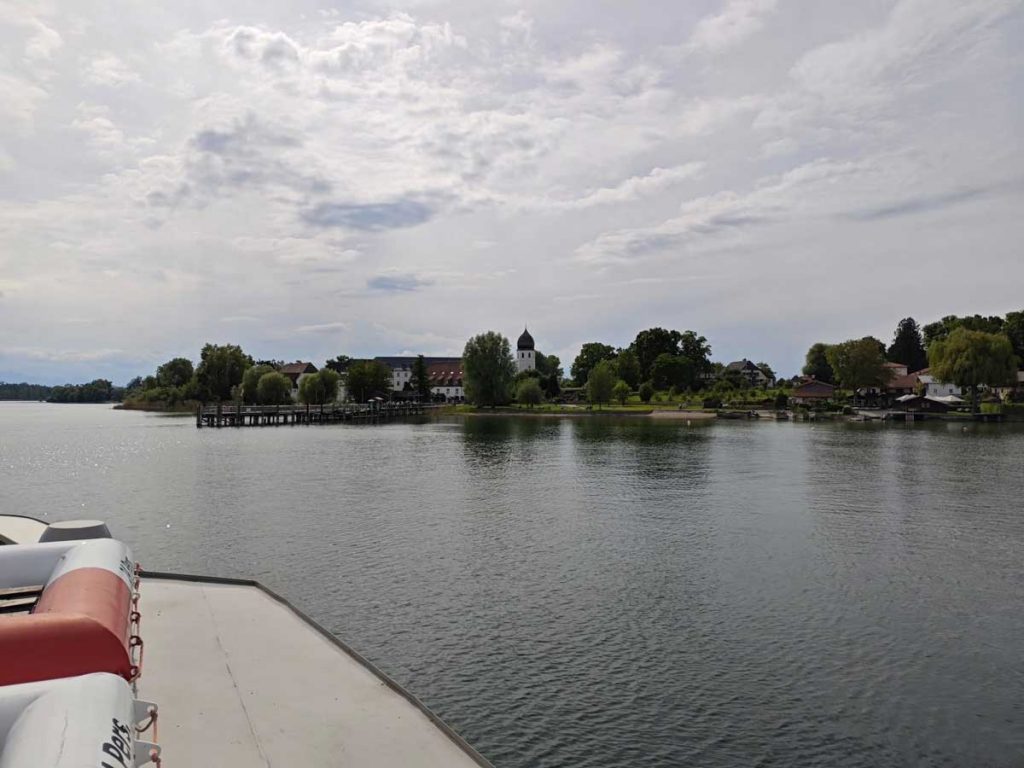
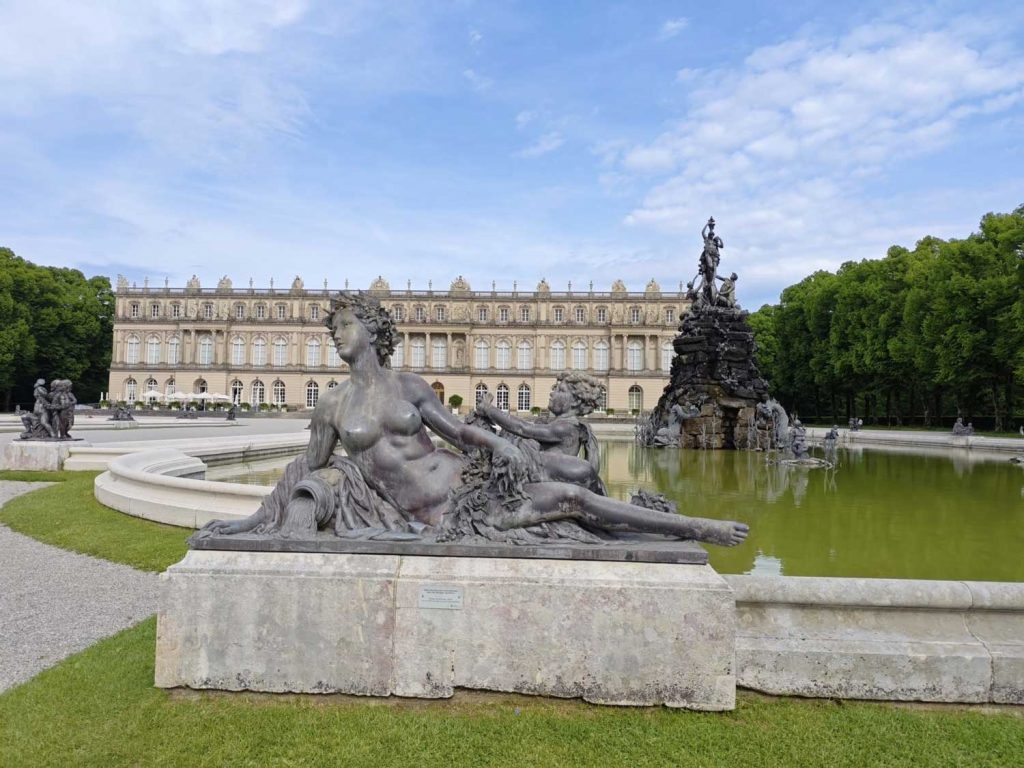
Returning to the mainland, we headed for our long-awaited overnight stop near the famous Lake Königssee. Again the navigator fell silent after a couple of words, and we once more began to circle around. We arrived at “Chiemsee Apartment”, in fact, an aparthotel, after eight, and discovered an unusual self-check-in method: a notice for late arrivals listing their room numbers. Keys and a registration form were in the room. Very convenient. Tomorrow we begin to explore the lake and its surroundings.
DAYS 3–4. Lake Königssee
Our hotel at Königssee turned out to be quite far awayfrom the lake itself, in the town of Inzell, a 40-minute drive from the lake. It was decent, but the bedrooms were so tiny that there hardly was enough space for a suitcase. Mine didn’t even have a window, so it was hot at night. On the first day we had logistics problems which delayed us a lot, and we only made it to the lake after lunch (by the way, so far all the food on this trip has been average or worse), setting off at 14:00.
A light drizzle was falling, and mists crept down the almost vertical slopes descending into the lake only adding romance and atmosphere without diminishing the beauty. I don’t know why, but the long, stretched-out shape of the lake was a surprise for me. Disembarking at the far end, we walked to the small Obersee lake (about 15 minutes); after that I returned to the pier while my companions continued farther up the valley (an hour and a quarter walk you can bring you to a waterfall), so we got back on one of the last boats (the last one left at 17:10; in summer, I hope, later). The lake is undeniably beautiful, but of those I’ve seen I still give the first place to Canada’s Maligne Lake.
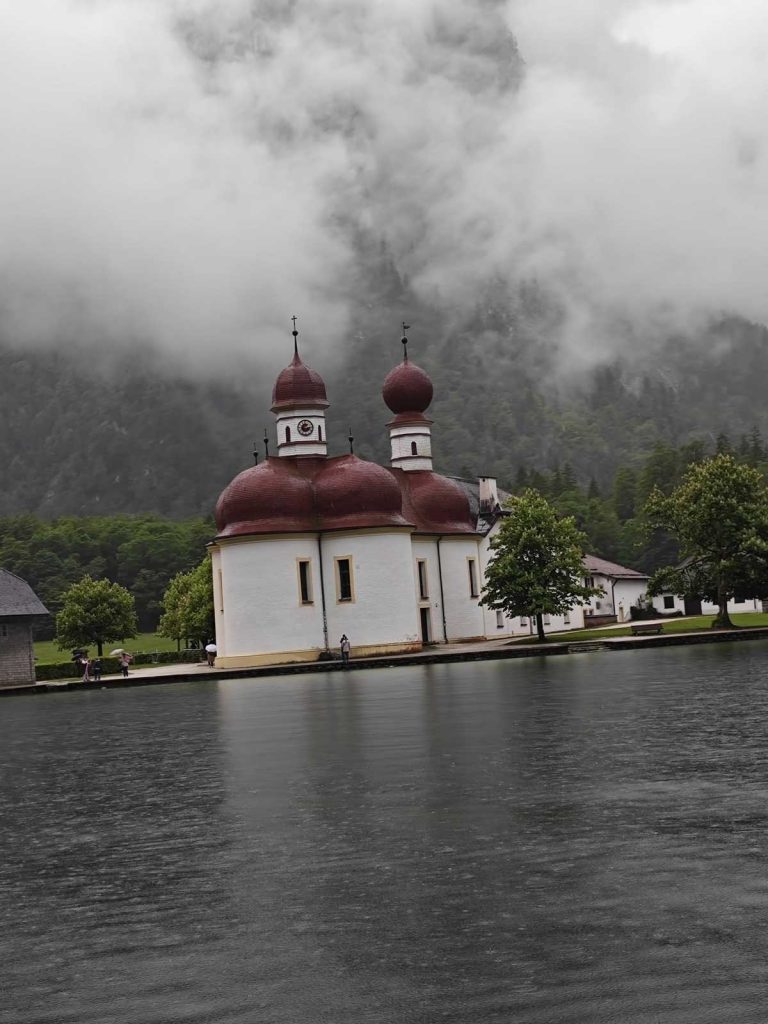
The next day was much busier. The weather cleared in the morning, and we headed to the Kehlsteinhaus, a building constructed by the Nazis in 1938 on the summit of the Kehlstein, a rocky spur at 1,834 meters, for government’s and public meetings. The place is known as the “Eagle’s Nest.”
The building itself isn’t interesting at all, but the views there are wonderful especially if you climb higher to the viewpoint. There’s a restaurant inside now, but my soup, with a huge bread-and-cheese knödel and a few lentils floating in it, I set aside after the very first spoonful as it was completely inedible, and the goulash ordered by one of my companions was at best nothing special.
To get to the Kehlsteinhaus you need to reach the so-called Documentation Center (Documentacion), from where a specially modified electric bus tackles the last 6 km up a narrow, steep road to the top.
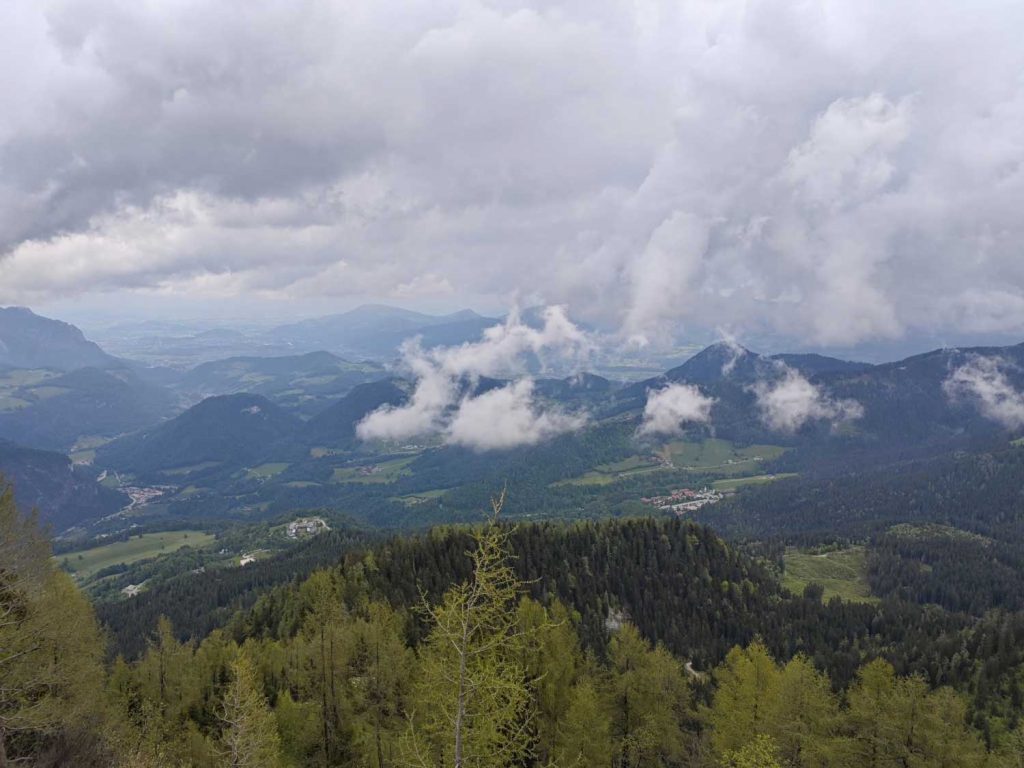
The bus costs €31.5; this price includes admission to the Kehlsteinhaus. From the bus a 124-meter tunnel leads inward, ending at an elevator that lifts visitors 124 meters up through the mountain to the house itself. Those travelling without a car can reach the Documentation Center on bus 838 from Berchtesgaden railway station for €5.6 round trip. Prices for ordinary souvenir magnets of Chinese mass production costing €3–3.5 across much of Europe are €5–6 in these parts (and further into Austria), while at the Kehlsteinhaus they’re €10. If they’re going to fleece you, they fleece you.
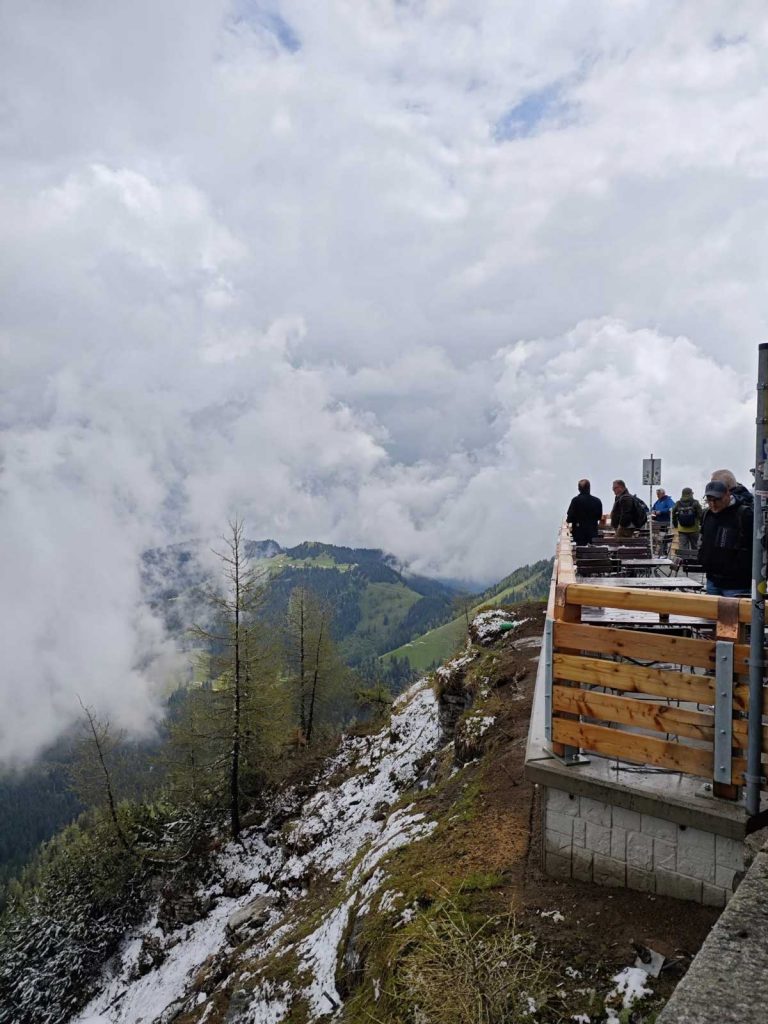
In Berchtesgaden, after descending from the mountains, we took a tour of the salt mine. It so happened that I hadn’t made it to the salt mines in Hallstatt (Austria), Wieliczka (Poland), or Romania, so this one came in handy. They issued us coveralls, and the group set off. An electric train carries visitors deep into the mountain.
The salt content in the rock does not exceed 50 percent, so the tunnels and halls of the mine aren’t white at all; their color depends on the predominant mineral in that section, and in places it’s very beautiful. But if you lick them, the walls are salty. (At the end of the tour you can taste a strong brine which, oddly enough, leaves a pleasant aftertaste once the sharp salty flavor subsides.)
Workers in the mine (and tourists) descend from one level to a deeper one by sliding down a roughly 30-meter, about 45 degrees steep wooden chute, polished to a shine by many thousands of bodies. Doing this for the first time is a bit scary, even though you know it’s safe. This “attraction,” as well as the barge ride across a mirror-like salt lake, turned out to be the most interesting moments of the tour. I can’t say it was unnecessary, but the €25 they charge for it is clearly too steep.
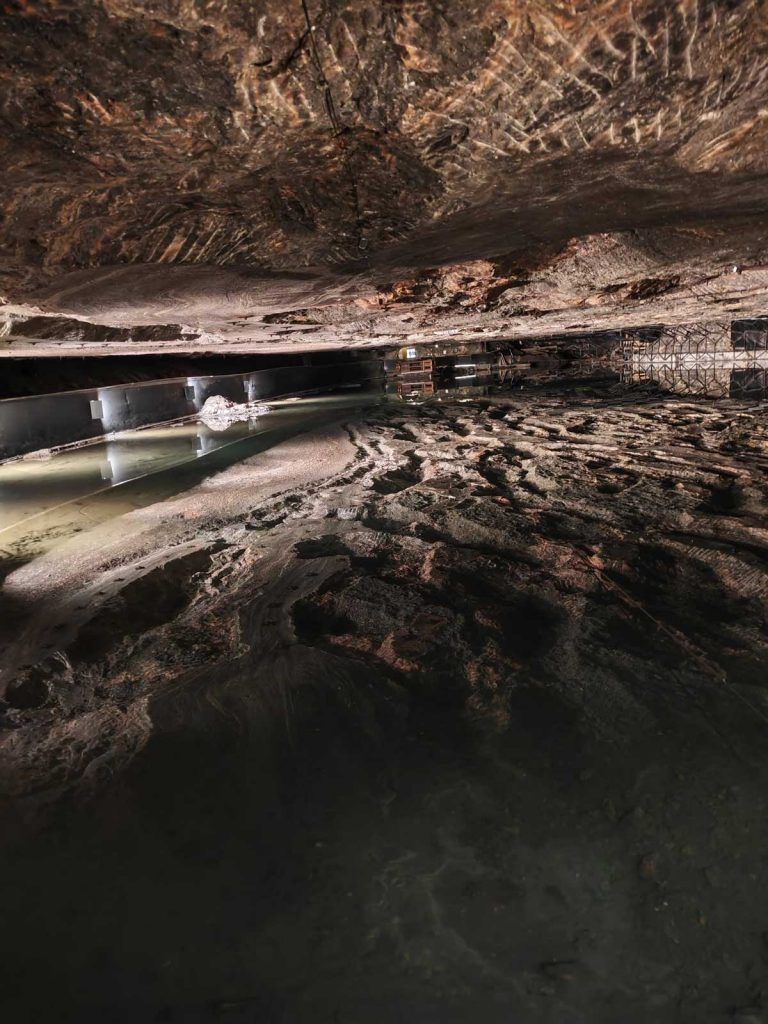
Having emerged from the mine, we took a drive along a much publisized toll panoramic road, from which we didn’t see anything special compared to what we’d already seen let alone what awaited us later in Austria. Thus ended our acquaintance with this area, which I’d been awaiting for 41 years since I sped past on the highway from Munich to Salzburg, only 25 kilometers from here. One day would have been enough.
DAYS 5–6. Austrian Section of the Route
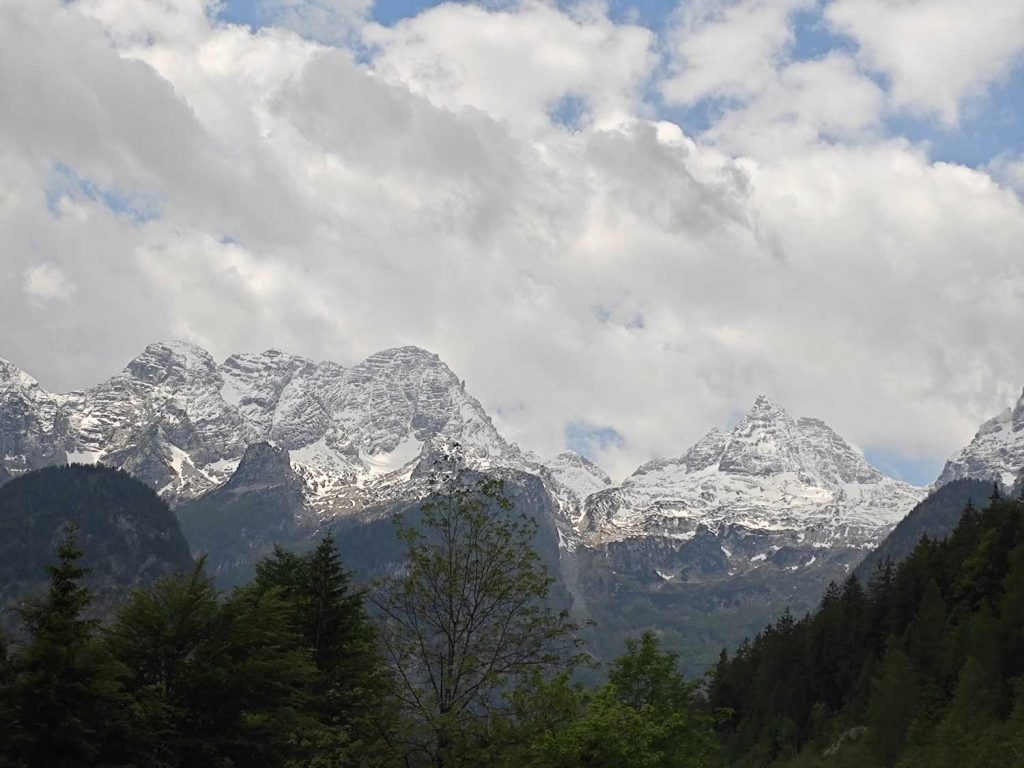
Not far from Lake Königssee we crossed the border with Austria (using a term practically defunct in Europe) on our way to the resort town of Zell am See. A pleasant town, but no fuss, located on the shore of yet another of Austria’s countless lakes. Its central square is dominated by a mostly Romanesque church with an unusual-looking bell tower ending in a roof without a spire.
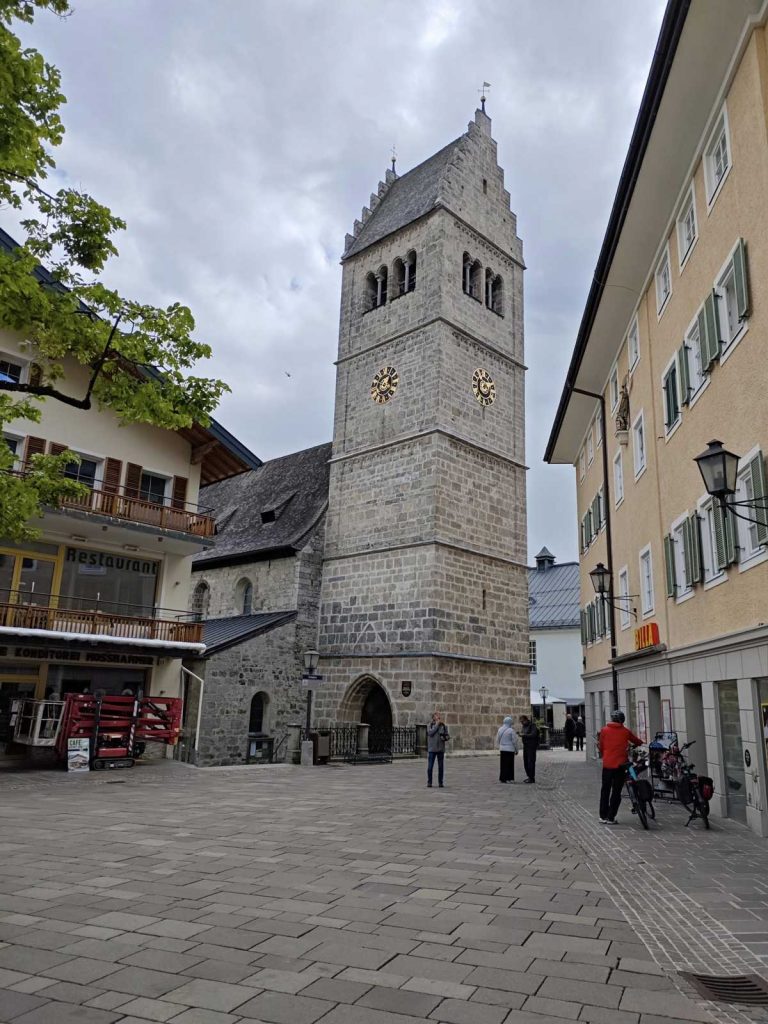
After a walk and a visit to one of the many local restaurants, most of them, for some reason, Italian, we drove to nearby Kaprun, a major ski resort. Here you can take a lift to an altitude of over 1,500 m, and another one up to a glacier at over 3,500 m. We had already been to the first hight the day before, and taking to the second lift would have meant parting with €75, which didn’t suit us, plus it was too late: we had already missed the last ascent at 15:30.
But right nearby was the place which was the reason why we went from Königssee to Garmisch-Partenkirchen via Austria: the Sigmund Thun Klamm gorge, carved out by a rushing mountain stream. It’s only 320 meters long, so climbing alongside it on steep stairways was not so hard a task.
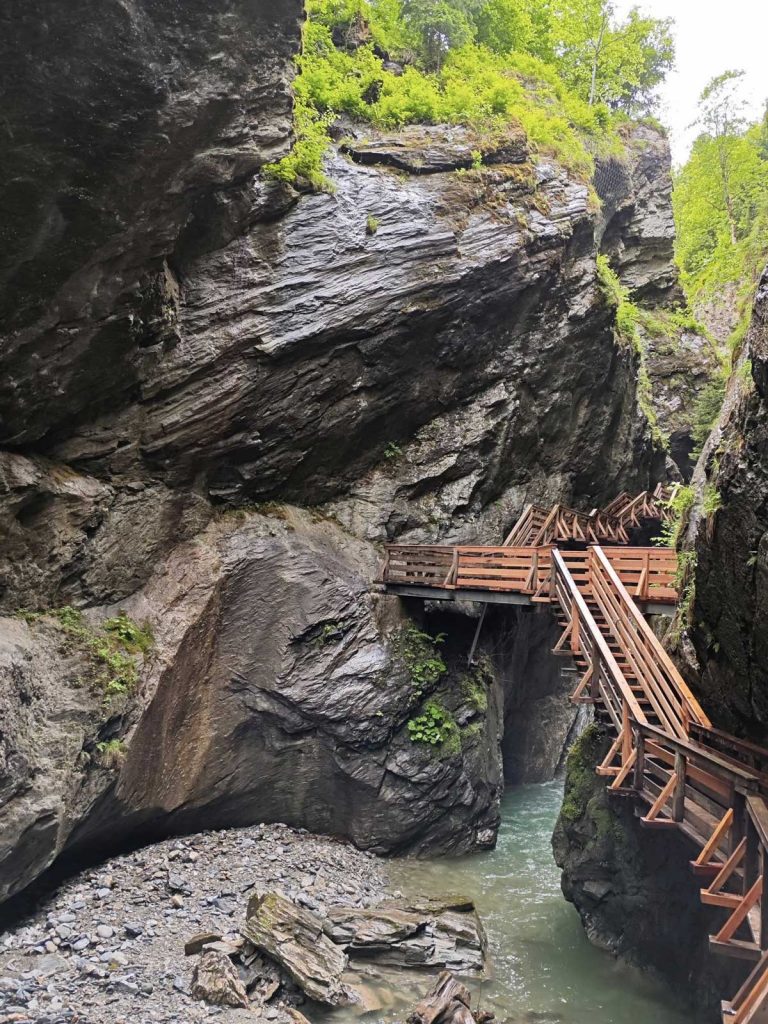
It reminded me of a hike through the Aare Gorge in Switzerland, but here it’s much more dramatic and steep. The water roars through a narrow gorge, its walls almost closing inat times, amid a chaos of huge rock slabs tilted toward each other at a million angles, as if some heavenly abstract sculptor had furiously hacked at the layered stone with a giant chisel. Absolute delight.
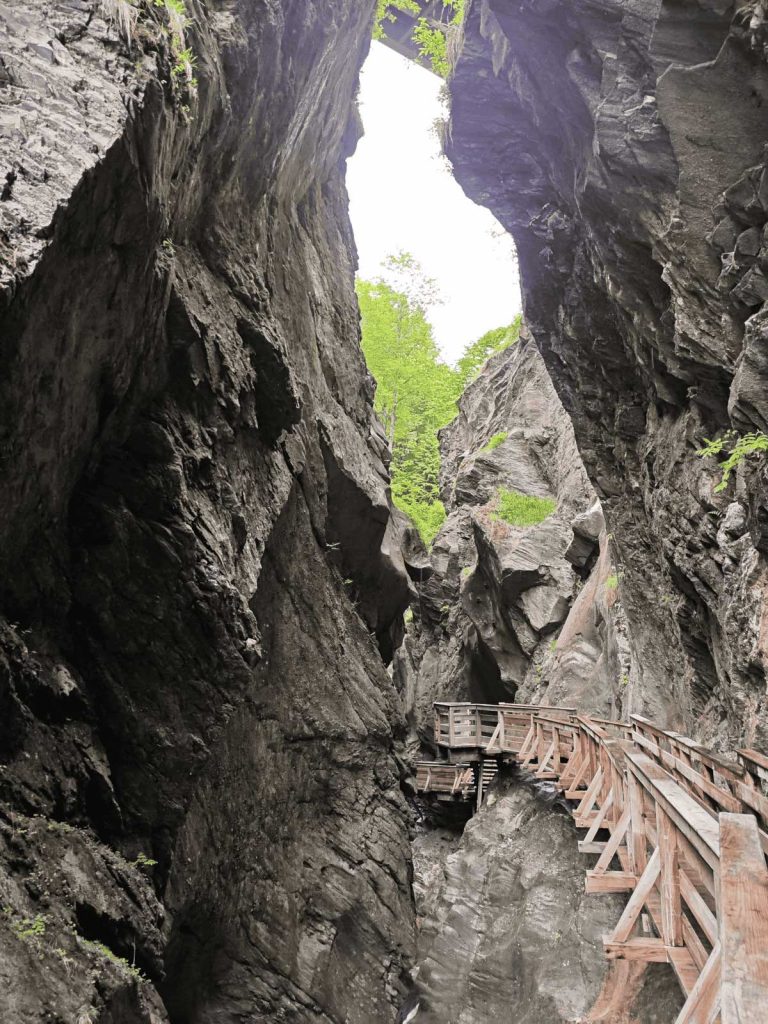
The gorge ends at a dam that has created the artificial Lake Klammsee, around which you can take a loop walk returning to the car either on one side of the gorge by a wide trail or on the other by a more demanding footpath. Water spills over the dam in a thin sheet, forming a beautiful curtain-like waterfall. The dam and reservoir are part of the hydroelectric plant built here, which also includes huge turbine halls carved into the mountain.

After the gorge, we set off on the long drive to our overnight stop, and luckily I missed the turn I should have taken. Luckily because instead of the shorter northern road to Innsbruck, we took the longer southern one (with one toll section costing €12.5) through the Gerlos Valley, which in places is of incredible beauty.
This gave my companions their first chance, and me after 41 years, to see even if from afar the famous Krimml Waterfalls (actually cascades), and from one of the viewpoints to admire a scene of waterfalls and mountains that was hard to walk away from. No less wonderful was the view from the hillside house where we stayed (no one there to meet us, just come in and stay, no check-in time limits, no key code), reached by a steep road barely wider than the car. You couldn’t tear yourself away from the window. A remarkable, inspiring day that even the rare, in our times, absence of Wi-Fi at the lodging couldn’t spoil.
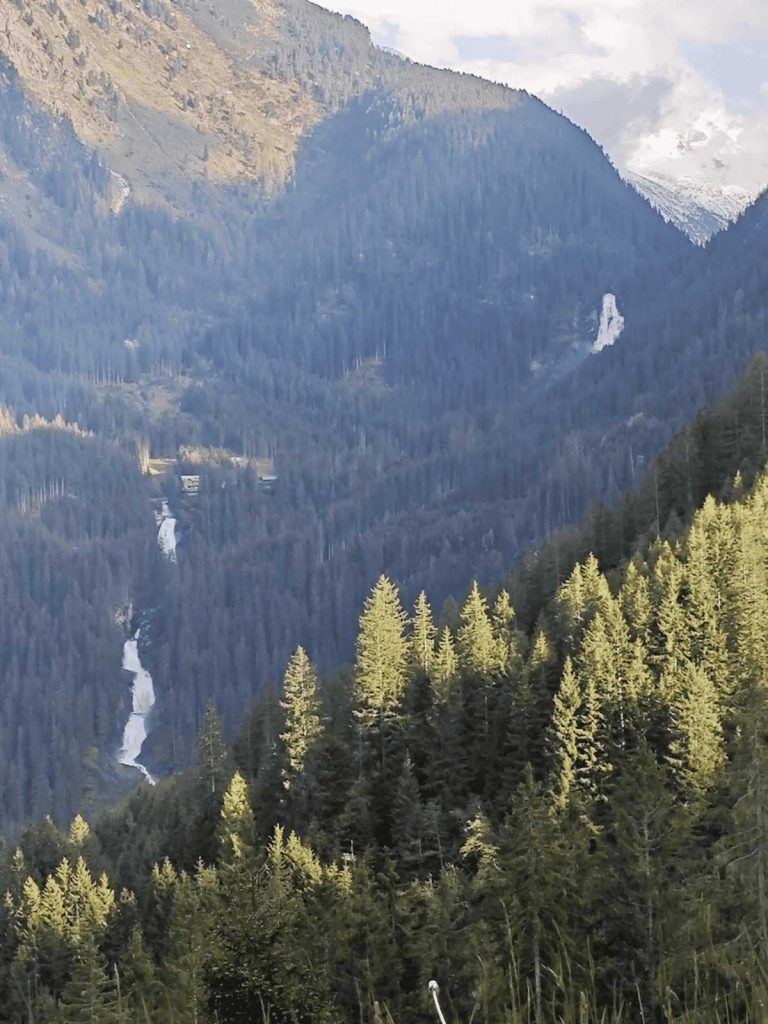
The next morning began in the refreshing chill of the accommodation, where the only warm place was the bathroom with a heater. The hope that our route would take us along a road through a scenic gorge between two mountain ranges that we saw from our window was not fulfilled; instead, we had to backtrack to reach the highway to Innsbruck. This passed by the Swarovski Museum. My companions happily went inside, while I stayed in the car to write these lines and take a nap.
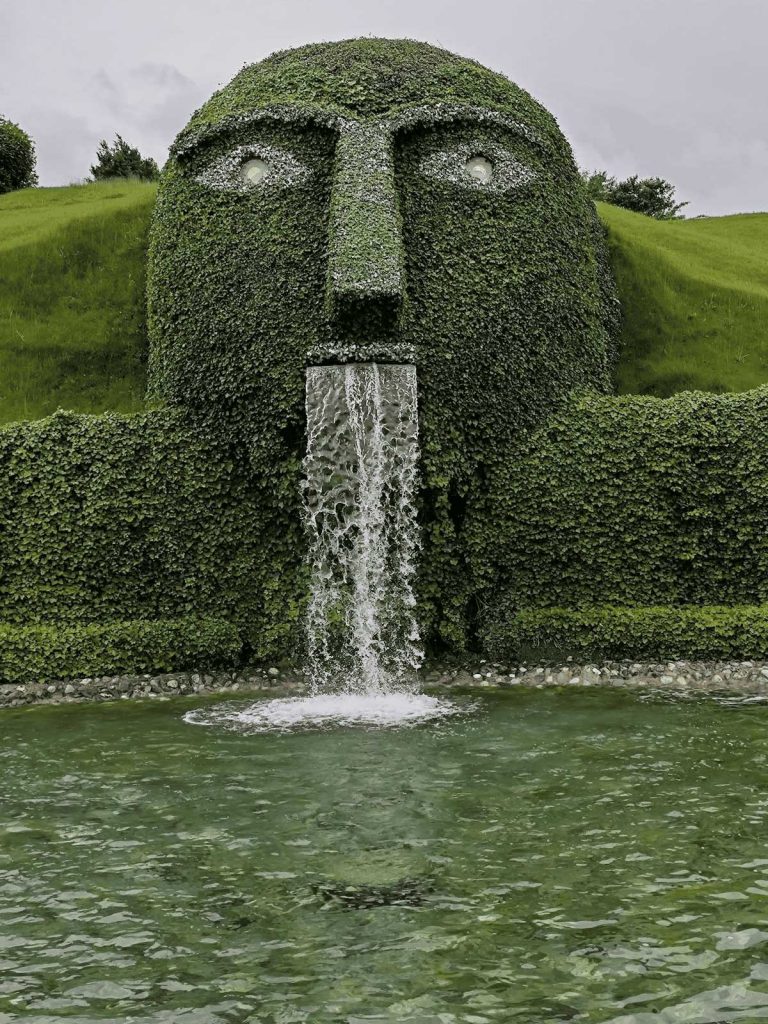
Then came Innsbruck. We strolled with great pleasure through its elegant center, admiring the beautiful, tastefully painted buildings. We spent a long time looking for somewhere to eat, but here, just like in Zell am See, there were only Italian restaurants and pizzerias at every turn. Finally, we found a small restaurant specializing in dishes based on white asparagus, very refined and unusual. And, naturally, expensive. But delicious.
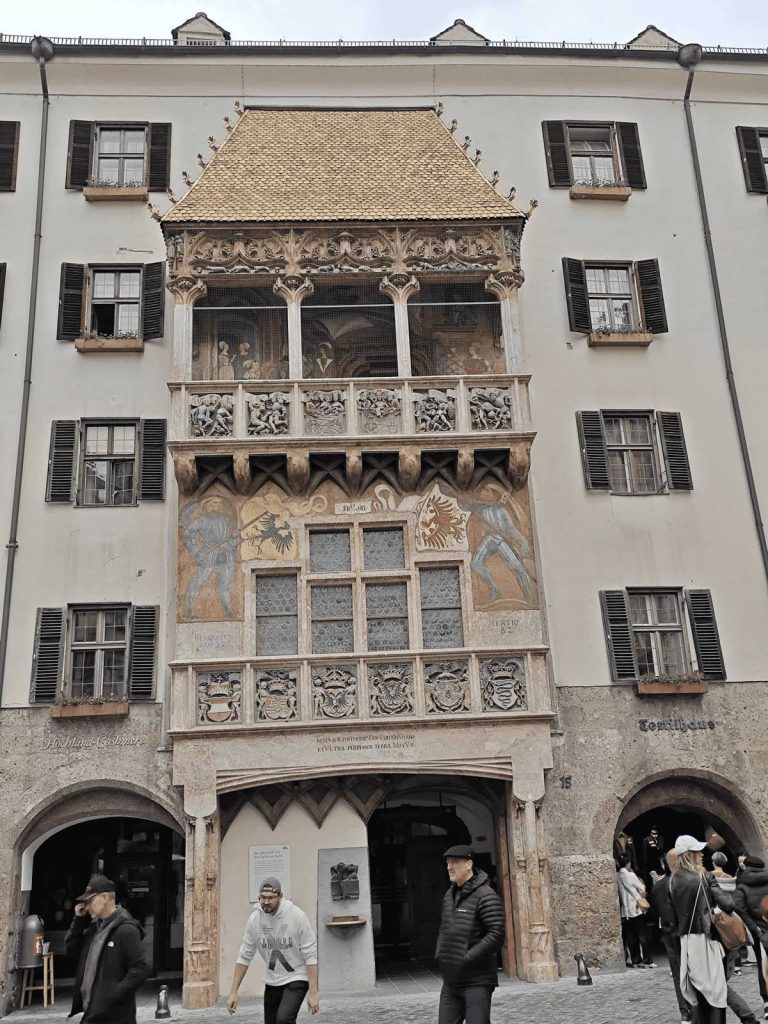
From Innsbruck we hurried to the Leutaschklamm Gorge on the Austrian–German border. The gorge is beautiful, but not as wild and impressive as yesterday’s. The best view here is from the Panorama Bridge. The gorge ends with a 23-meter waterfall. To see it, you have to descend to its base via a steep stepped trail (and then return the same way). Moreover, after descending, I discovered that access to the waterfall was closed. They could at least have posted a notice somewhere.
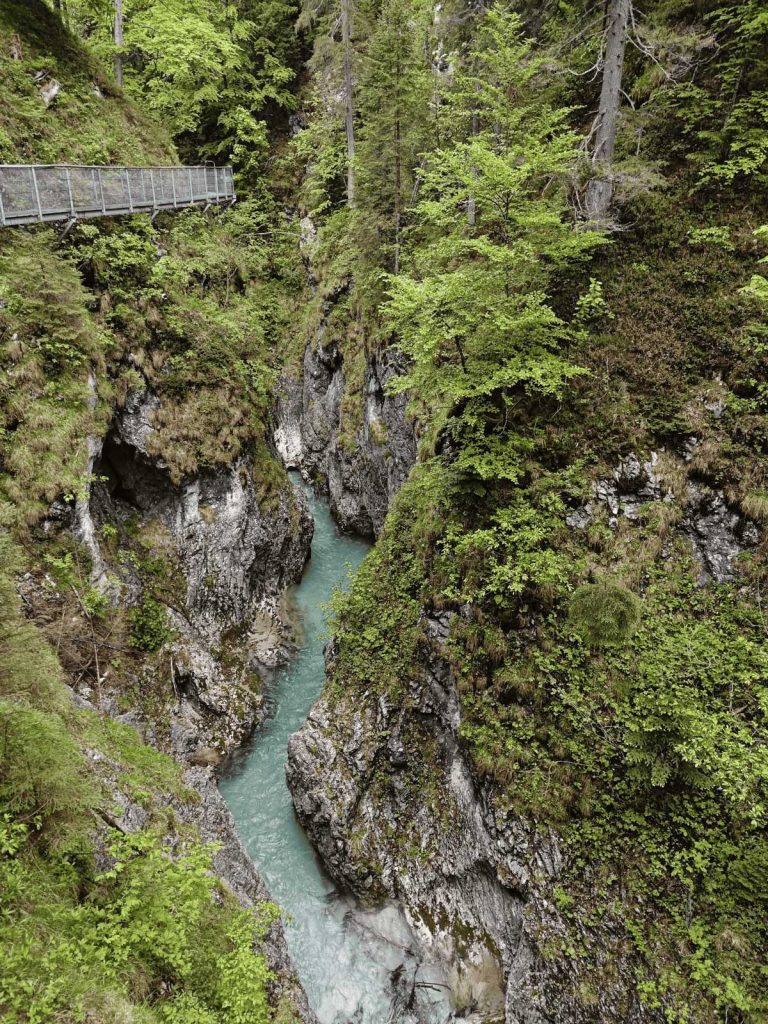
Because of time constraints I practically flew back up this steep trail, surprising even myself. As a result of all our detours we missed the check-in deadline at our hotel in Garmisch-Partenkirchen (18:00) and were forced to book another one for the night. Laxity is punished, especially in Germany. But this kind of arrangement is rather strange. I’ve never encountered such strict conditions for tourists, and while searching for hotels I even saw some (in Austria) with check-in limited to before 17:00. Very inconvenient.
DAYS 7–9. Garmisch-Partenkirchen
Our unplanned overnight stop turned out to be half an hour’s drive from Garmisch-Partenkirchen, already in Austria. Wonderful and inexpensive apartments. In the morning we found out we were very close to the places planned for that day. However, the day itself turned out not to be very eventful and rather unremarkable.
The first stop was supposed to be the Haeselgehr Waterfall, but when the GPS announced “You have arrived at your destination,” there was no sign of anything of the sort. Not a soul around, and with rain falling, we didn’t feel like going to search, so we drove on. As for ascend to the Zugspitz, the highest mountain in Germany (2,973 m), straddling the border between Germany and Austria, was shrouded in clouds and mist, so this idea had also to be abandoned.
After missing out on walking the famous suspension bridge in Portugal, I really wanted to cross the local Highline179 suspension bridge, but it turned out to run above a road and the ruins of a small castle, now housing a museum, nothing really exiting. I might have climbed up to the bridge, but the lift was out of order, and the incentive for a climb up the steep path wasn’t strong enough. Above the bridge entrance rise another set of ruins, quite romantic.
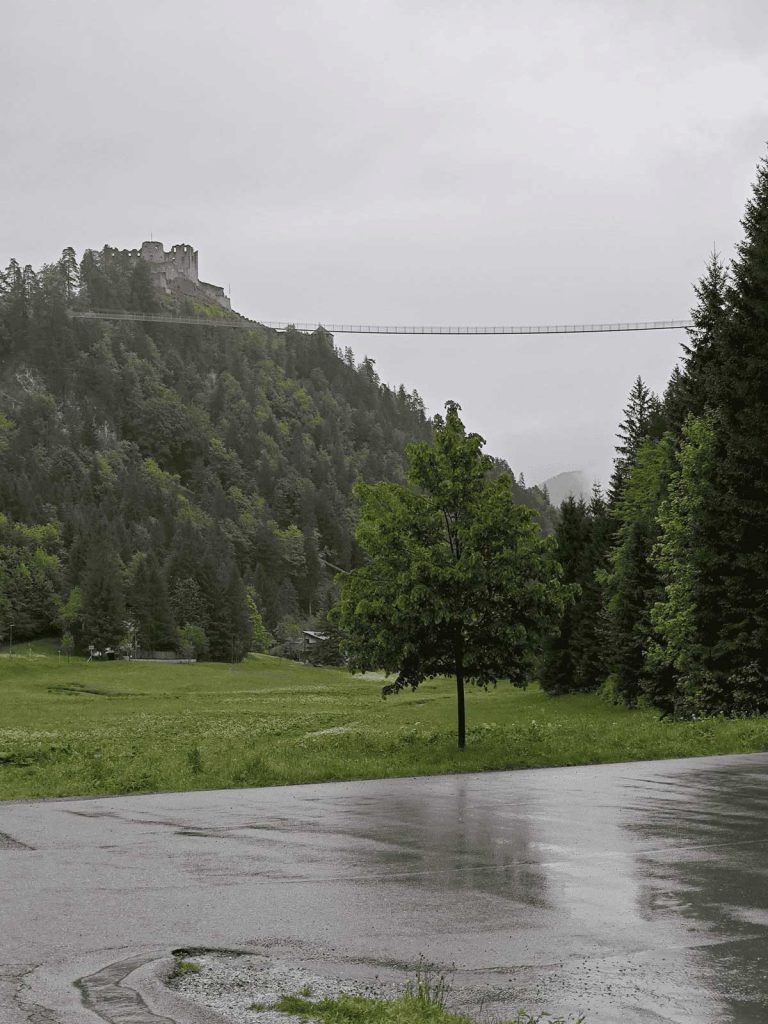
From the Highline179 we returned to Germany, to Lake Eibsee. The lake turned out to be rather ordinary, and a walk around it would have taken two to three hours which we didn’t have. Next to the lake’s parking lot is the lift to the Zugspitze from the German side (I’ve read it’s more interesting from the Austrian side), so these two sights can be conveniently combined.
Back in Garmisch-Partenkirchen, we finally checked into our apartment (very nice, with two toilets and two shower cabins – a rare find) on the very edge of town with a view of the mountains. Before that, we had an excellent lunch at “Das Kafe Boersa,” with tasty food, large portions, and reasonable prices (Ludwigstrasse 103). Its two owners are clearly enthusiasts who want not only to earn money but also to please their customers.
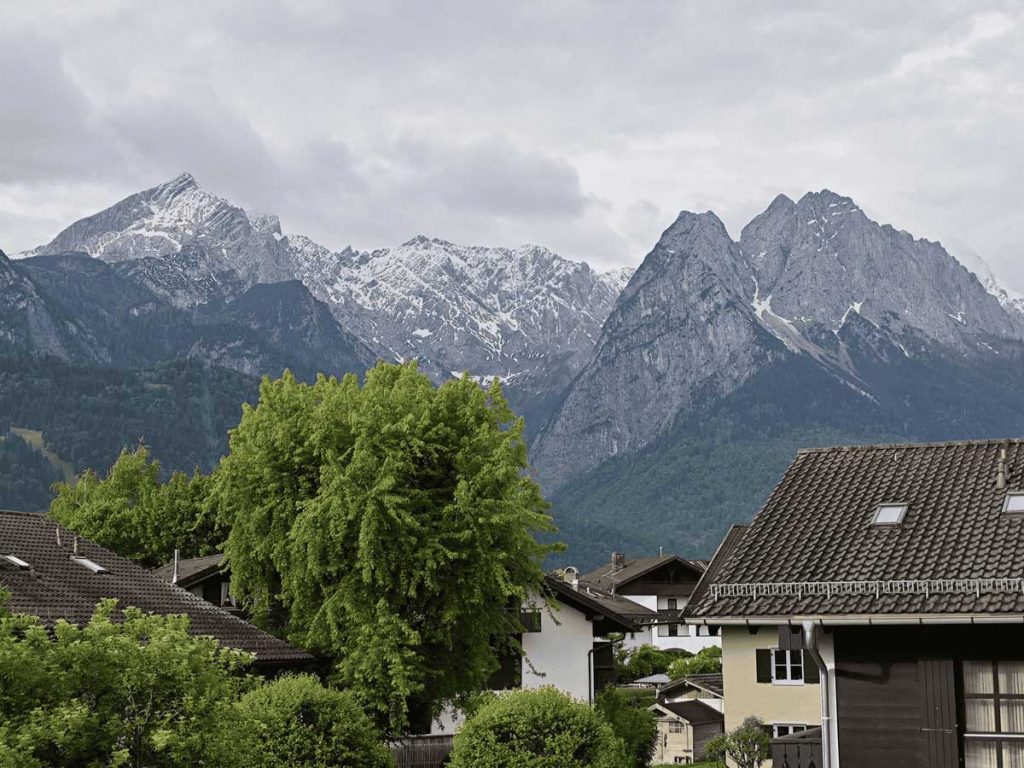
The second day was more successful. From what I have read about it, I thought the hike through the Partnachklamm Gorge would be very long and difficult, but it turned out that the gorge itself is short, with the rest being trails in the surrounding mountains. It’s about a half-hour walk from the parking lot to the gorge (or you can take a horse-drawn carriage).
The gorge is beautiful and powerful, with the roar of water and walls almost meeing in places. Alongside it runs a tunnel with windows, climbing gently. Tickets can be bought at the tourist office by the parking lot, at the ticket booth before the entrance, and from a machine right before the turnstile. After walking through the gorge (15 minutes), you can continue in two directions: either to a hut at nearly 1,000 m altitude (45 minute walk; the return can be made by a different route, 35 minutes to the lower entrance), or to the upper station of the cable car (35 minutes).
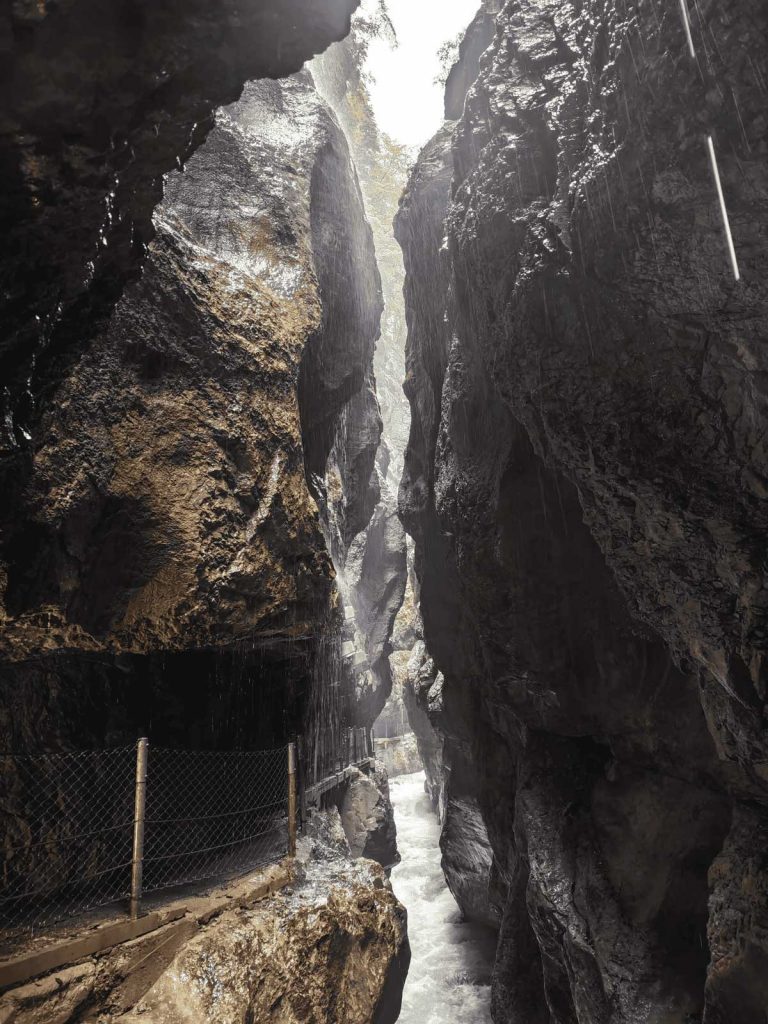
Knowing all this in advance, I’d probably have chosen this option: take the cable car (its lower station is before the gorge entrance) up, then walk down through the gorge in reverse. By the time we finished our walk through Partnachklamm, the rain had stopped, and, encouraged, we headed to Oberammergau.
This village is famous for its Passion Play, staged every ten years for 380 years already and covering the final period of Jesus’s life, from his entry into Jerusalem to the crucifixion. All participants – actors, singers, musicians, and technical staff – are villagers. The most recent production in 2022 involved over 2,000 people. The village is also known for its woodcarving (very expensive) and its many painted houses. We strolled leisurely, had lunch, and took a lot of photos (especially beautiful is the house painted with scenes from the fairy tale “Hansel and Gretel”).
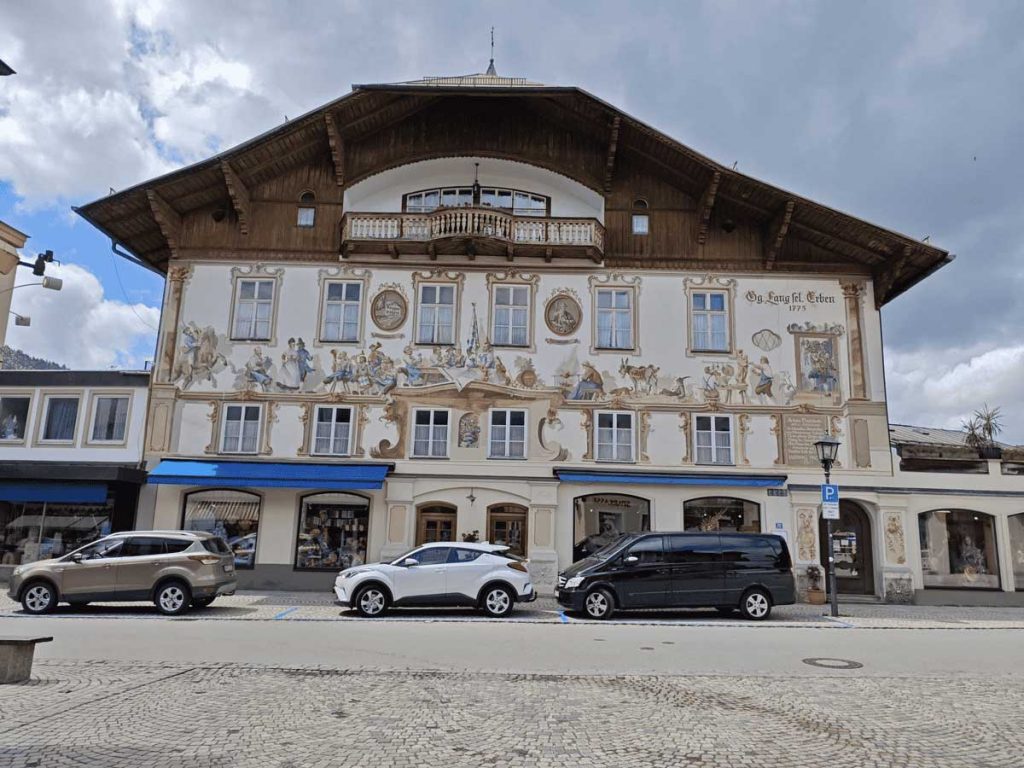
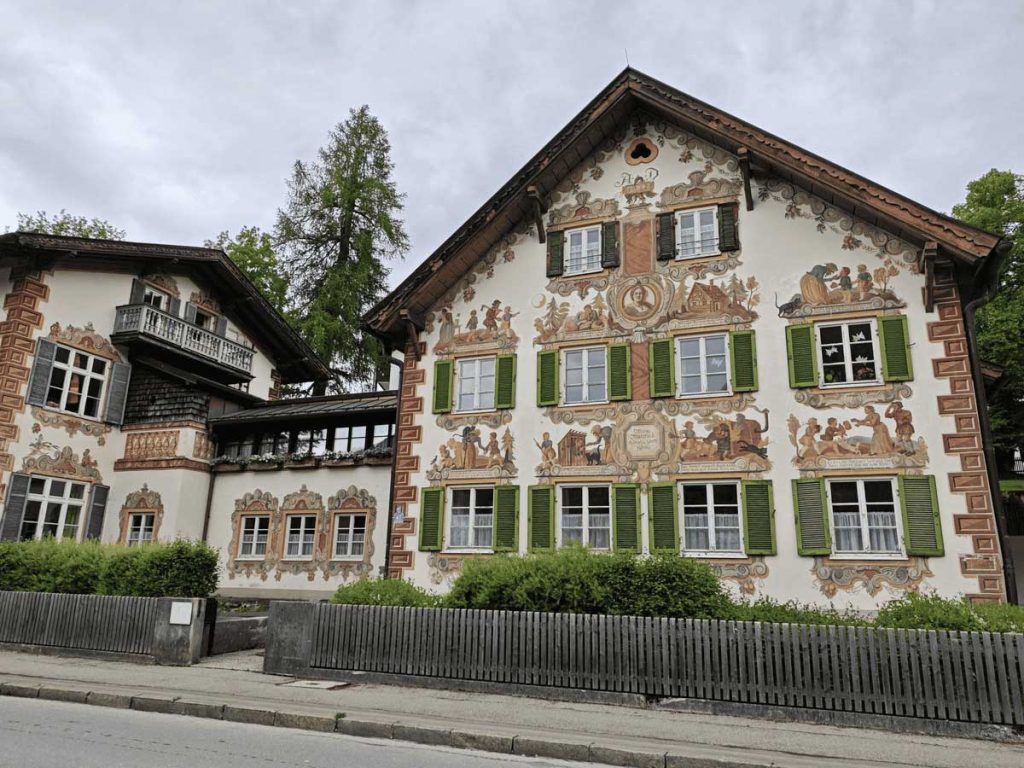
From Oberammergau we drove to the 18th-century Wieskirche, a masterpiece of Bavarian Rococo. From my long-ago trip to this area, I somehow remembered it as being very plain outside. It turned out to be beautifully decorated in pale tones on the exterior, and inside it was a riot of Rococo with a beautifully painted ceiling. Not a soul around, perhaps because it was already past six. The church is open from 8:00 to 20:00, which is very convenient. On the way back we passed the huge Ettal Monastery, which would also have been worth visiting had we arrived earlier.
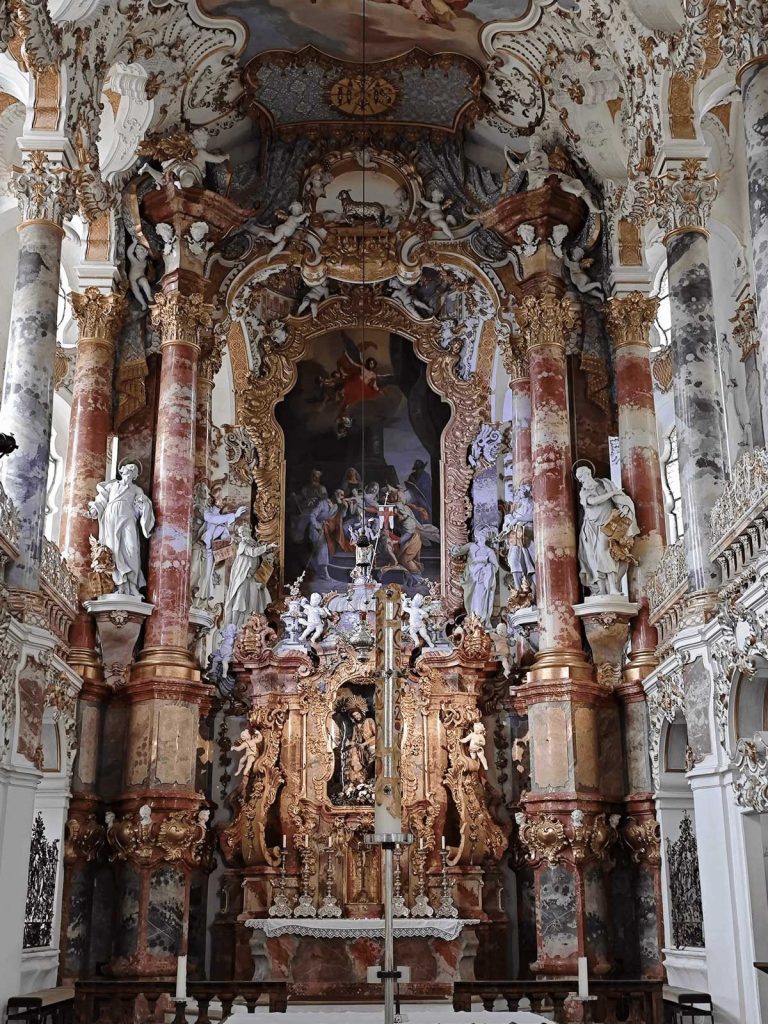

The third day in this area finally began without rain. We hiked to the Kuhflucht Waterfalls, which descend in three cascades to the village of Farchant, actually a suburb of Garmisch-Partenkirchen. Of the three starting points, I chose a small (and free) parking lot at Loisachstrasse 4, Farchant, from which it’s a 50-minute walk to the waterfall.
A relatively easy walk up a beautiful, narrow, wooded valley brings you to a bridge over the stream, from which you can take one of the best shots of the trip. After the bridge, a sign reads “End of safe path. Proceed at your own risk” (overly cautious, nothing dangerous), followed by a short, steep stairway to the lower cascade. The map shows a path to the upper cascade, but in reality it doesn’t exist. Even so, the walk was very pleasant, especially without rain. In one spot by the river there’s a tiny pool with loungers.
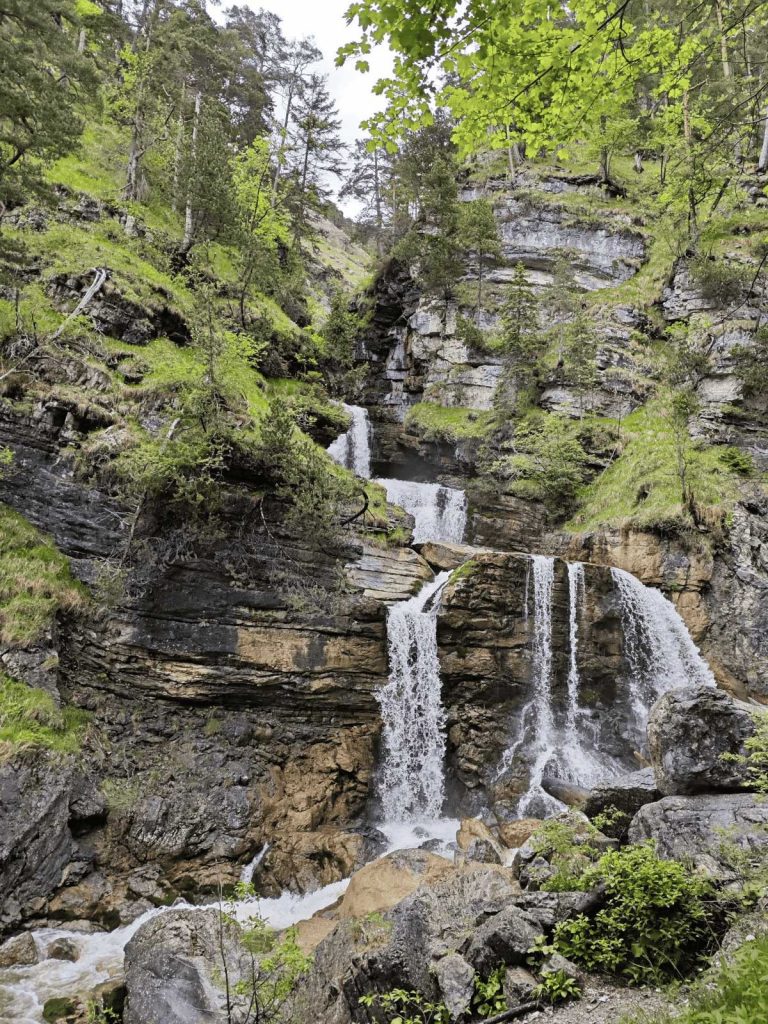
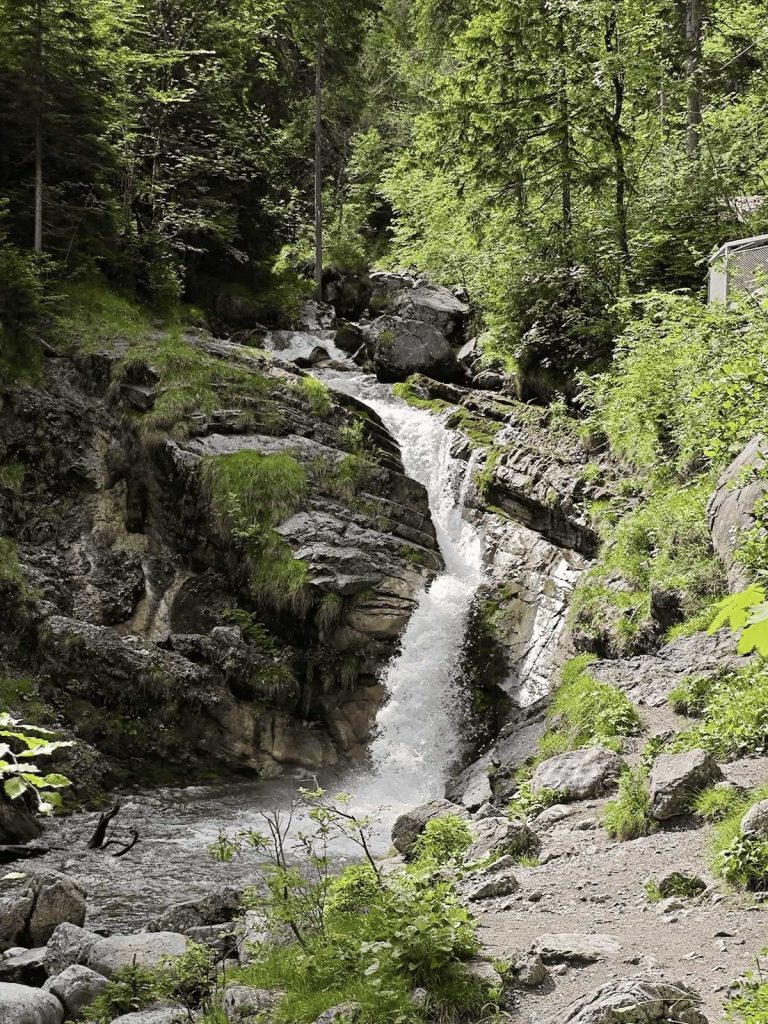
After returning to Garmisch-Partenkirchen, we strolled along Ludwigstrasse, taking photo after photo of the painted houses we couldn’t resist capturing. After that, under the rain that had started again, I drove my companions to the train station, from where they departed for Munich Airport. The rest of the trip I would make in proud solitude.
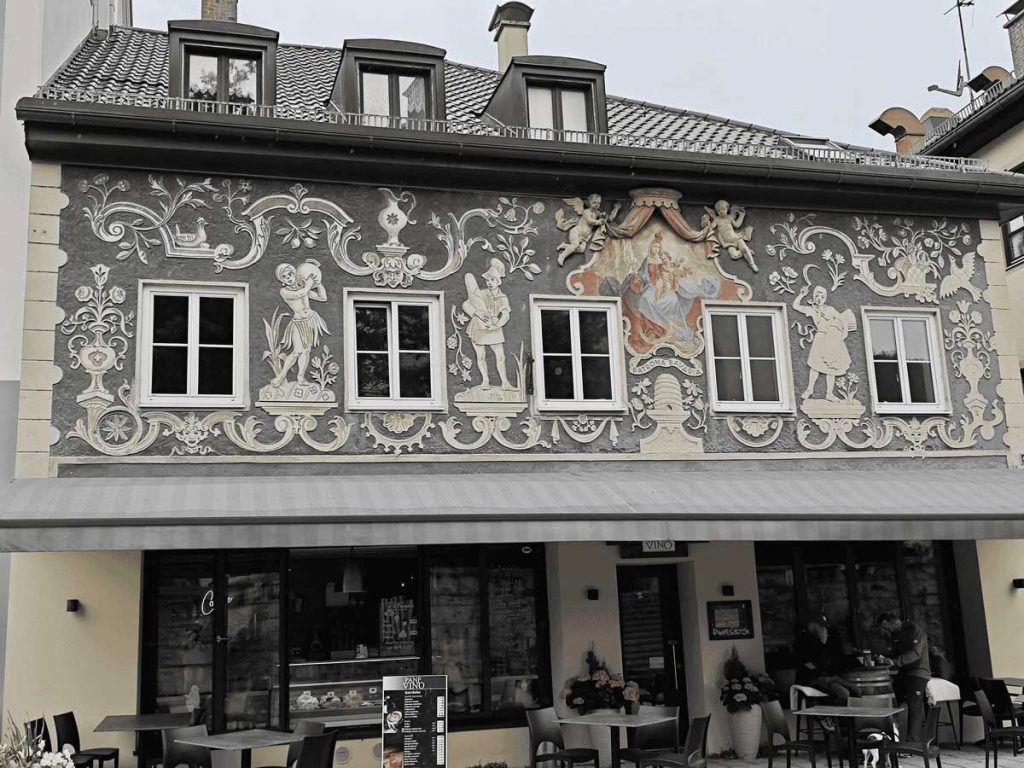
Day 10. Memmingen
In the morning it was still drizzling, but before my departure the rain stopped. It seems the streak of rainy days are finally over. The city was empty: today is a religious holiday and everything was closed. On the way north, I decided to make a small detour to visit Ettal Monastery. Its church turned out to be unusual: a large circular hall as the main space and another small one instead of the apse.
The huge dome above the main hall is beautifully decorated. Again, a luxurious Rococo with plenty of gold, but everything very elegant and balanced. I couldn’t take pictures: a service was being held. From the doorway I caught a glimpse of a delicate balcony of uncertain purpose. Perhaps for important figures. The monastery is known for its cheeses, beer, and liqueurs.

The next stop on the way to Memmingen was in Murnau. I walked along its main street, photographed more beautiful buildings, and the Münterhaus, also called the “Russian House” (Russenhaus), where Wassily Kandinsky lived for several years with his fiancée, the German painter Gabriele Münter, and where they hosted other artists from their group “The Blue Rider,” among them Alexei von Jawlensky. Unfortunately, the house was closed.
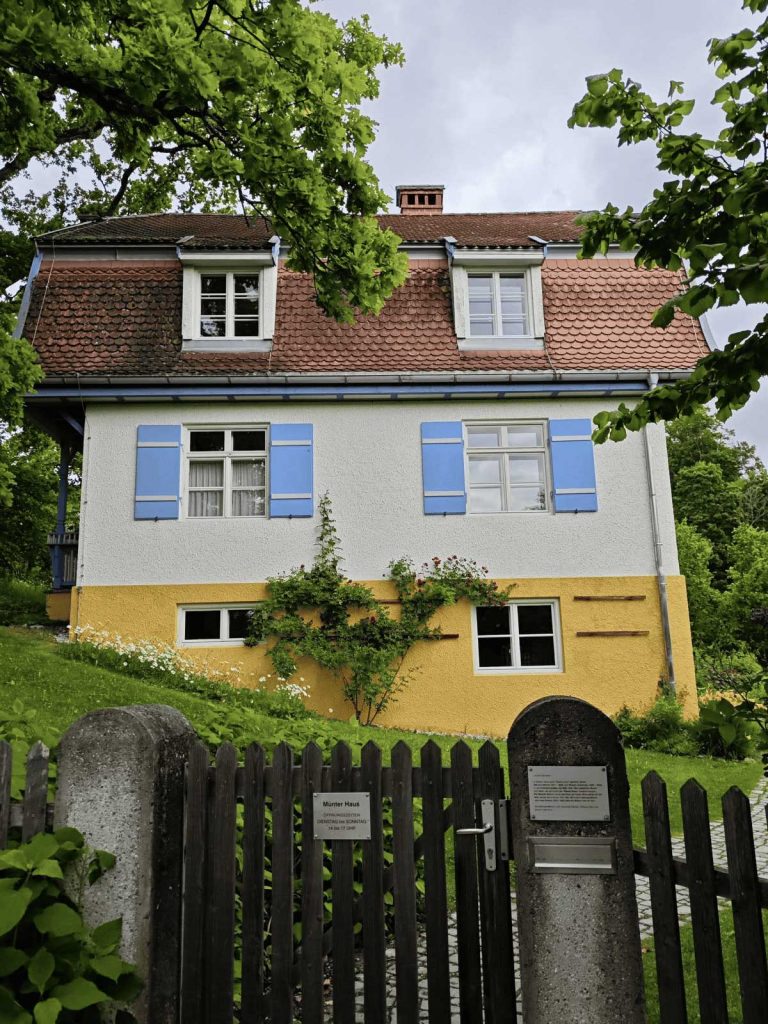
I arrived in Memmingen early, so I immediately set out to explore the city. I managed to photograph several buildings, including the unusually designed town hall, and then I noticed on one of the streets a crowd of several dozen, perhaps a hundred people. Mostly elderly, but not only.
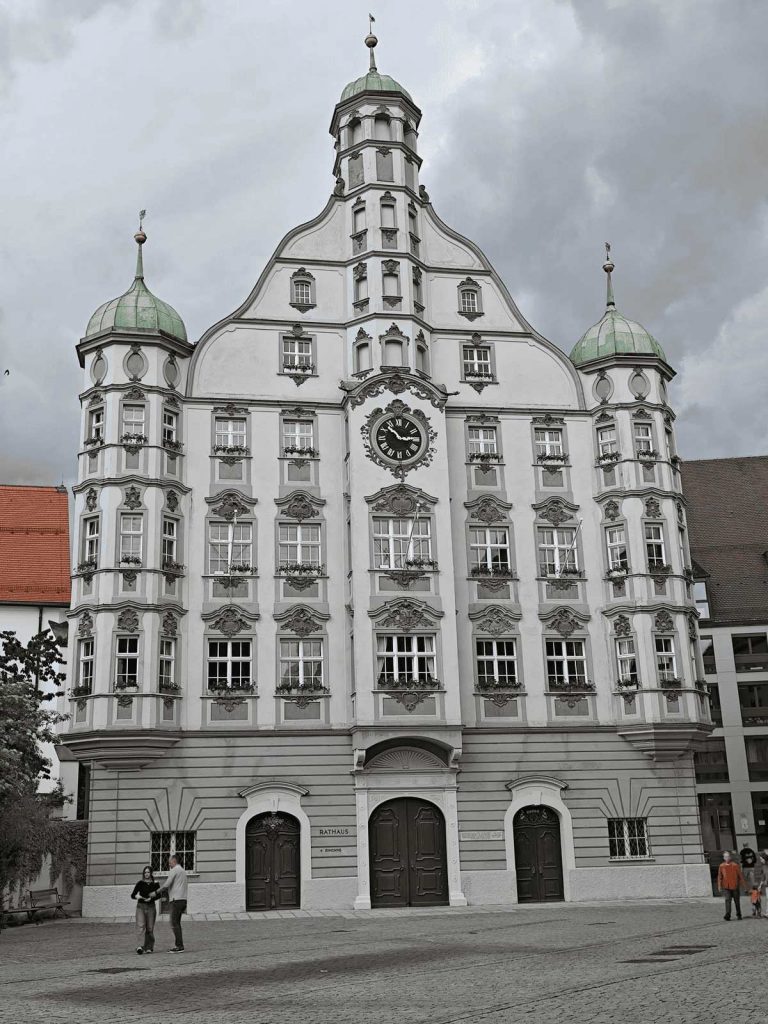
As I got closer, I saw Israeli flags and ribbons of solidarity with our hostages. It turned out to be the “March of Life,” organized by a Christian group whose mission is to fight antisemitism and spread the truth about Israel. At the moment I came closer, they were reading out the names of 139 residents of the city and surrounding area who perished in the Holocaust. When they finished reading, I stepped up to the microphone, introduced myself, and thanked them for their support and warm feelings toward our country.
In response, many of them came up to me, shook my hand, embraced me. An elderly man’s eyes were filled with tears. It was very moving. Some of them knew a little Hebrew. I walked the entire march with them in a place of honor, at the head of the column. At the stops, one of the organizers spoke about the Holocaust, the holiday of Simchat Torah, the tragedy of October 7, the history of the city’s Jewish community. A young woman named Anna, who had just returned from Israel where she had participated in the March of the Nations, sang Israeli songs in Hebrew and Hatikvah, our anthem. On my travels I more than once had unexpected encounters and coincidences, but something like this… never.
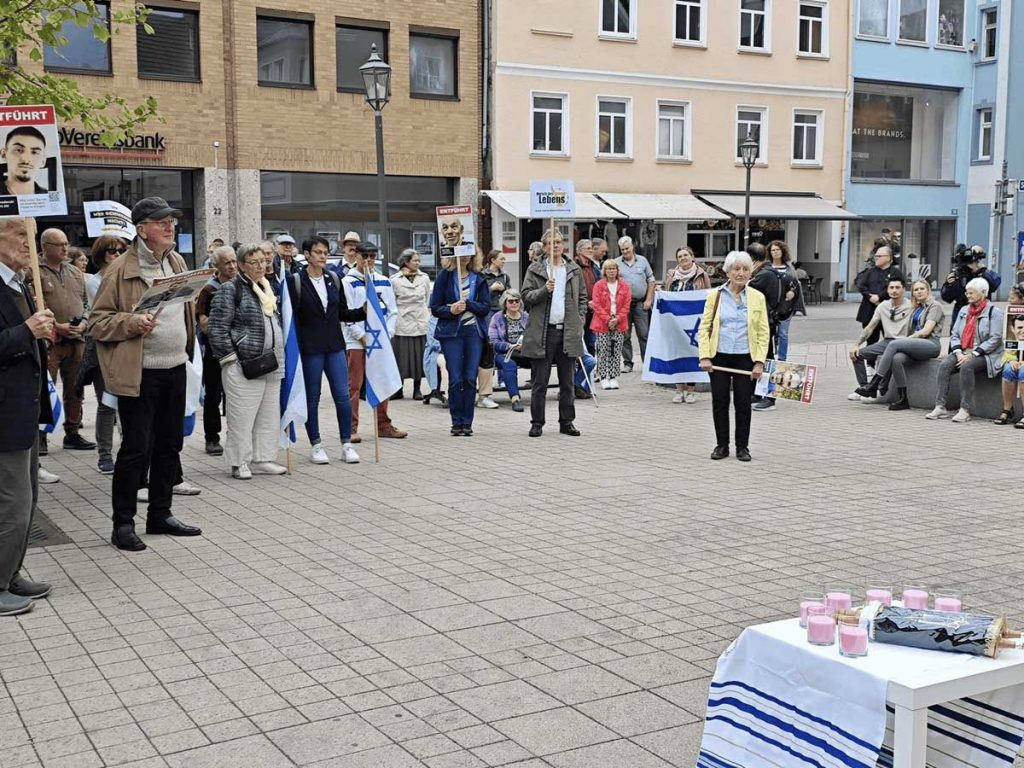
Day 11. More of Memmingen and Hohenzollern Castle
In the morning I walked a bit more around Memmingen, taking photos of the city gates, the fountain, and the House with Seven Roofs. I strolled along the streets named after guilds – Tanners, Bookbinders, and various other professions. I really liked this town; no wonder it has such good reviews. I was reluctant to leave, which doesn’t happen to me very often.The last time I felt this was in the Portuguese town of Guimarães.
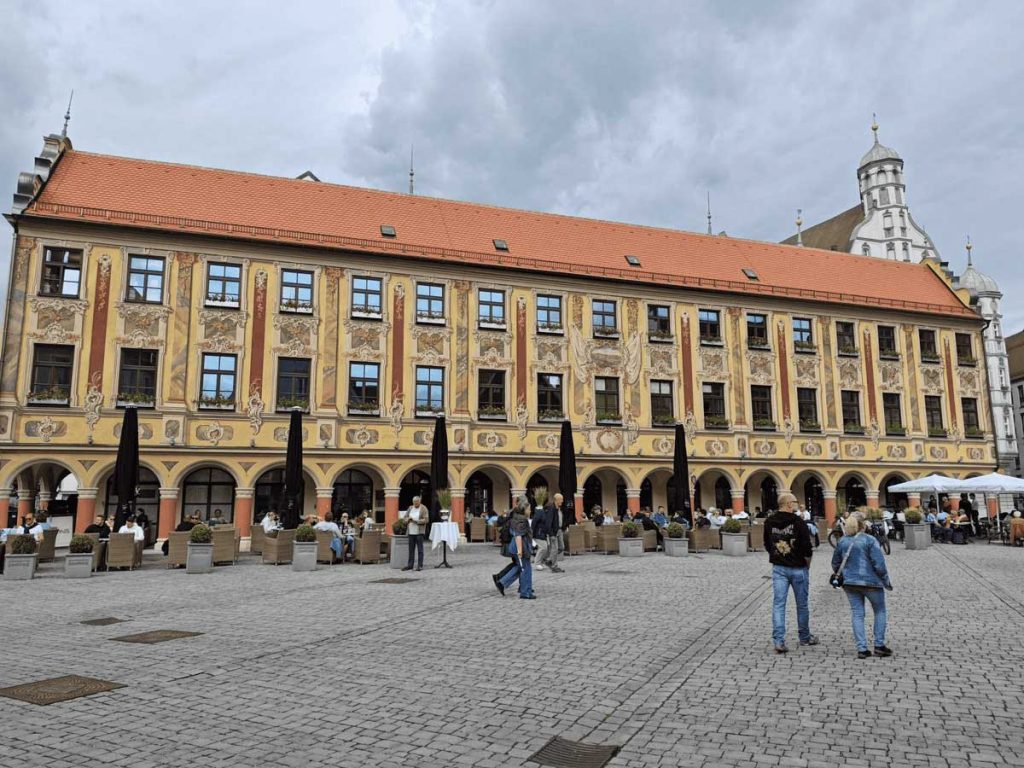
I also want to recommend the hotel where I stayed in Memmingen. Its name sounds rather bureaucratic and not very trustworthy: A2 Boarding House. But it turned out to be a brand new hotel, spotless, all in light colors. My single room was tiny, but it had everything necessary, including a small kitchenette (with a strange warning: “Cleaning of the kitchen is not included in the cost of room cleaning”). At the same time, the bathroom was quite spacious, with a normal-sized shower cabin (in previous hotels the cabins were the size that large people could barely fit in, let alone shower comfortably).
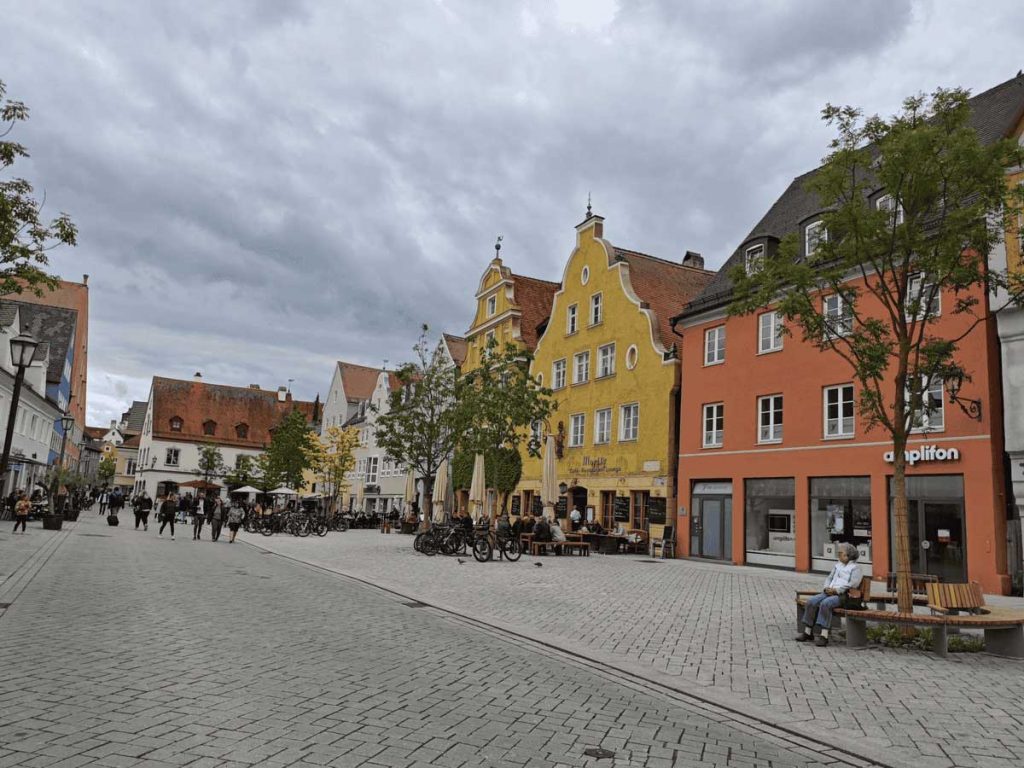
This was a day of long roads but few attractions, so I added Blaubeuren to the programm. The road there ran through the outskirts of Ulm, and I couldn’t resist the pleasure of turning into its center to once again see the Münster, a Gothic cathedral (founded in the late 14th century and completed only in the 19th) with the tallest spire in the world (just over 161 meters). The huge five-nave church can hold up to 20,000 people.
Blaubeuren turned out to be not very interesting, but as they say: “Better to do it and regret, than not do it and regret.” And in such cases, I never regret anyway.
Then, after a long drive mostly on small empty roads through fields and forests (the kind of roads I love), the spires of Hohenzollern Castle croped up in the distance. This 19th-century Neo-Gothic castle stands on a high hill – you can even call it a mountain – with views that make you feel like being on a plane. For some reason, I decided to go inside, although lately I usually skip such places. That decision cost me 29 euros. Quite a sum. The parking lot is far from the castle, and those with tickets are taken up by shuttle. The castle is open until 6:30 p.m., with the ticket office and entrance closing at 5:30.
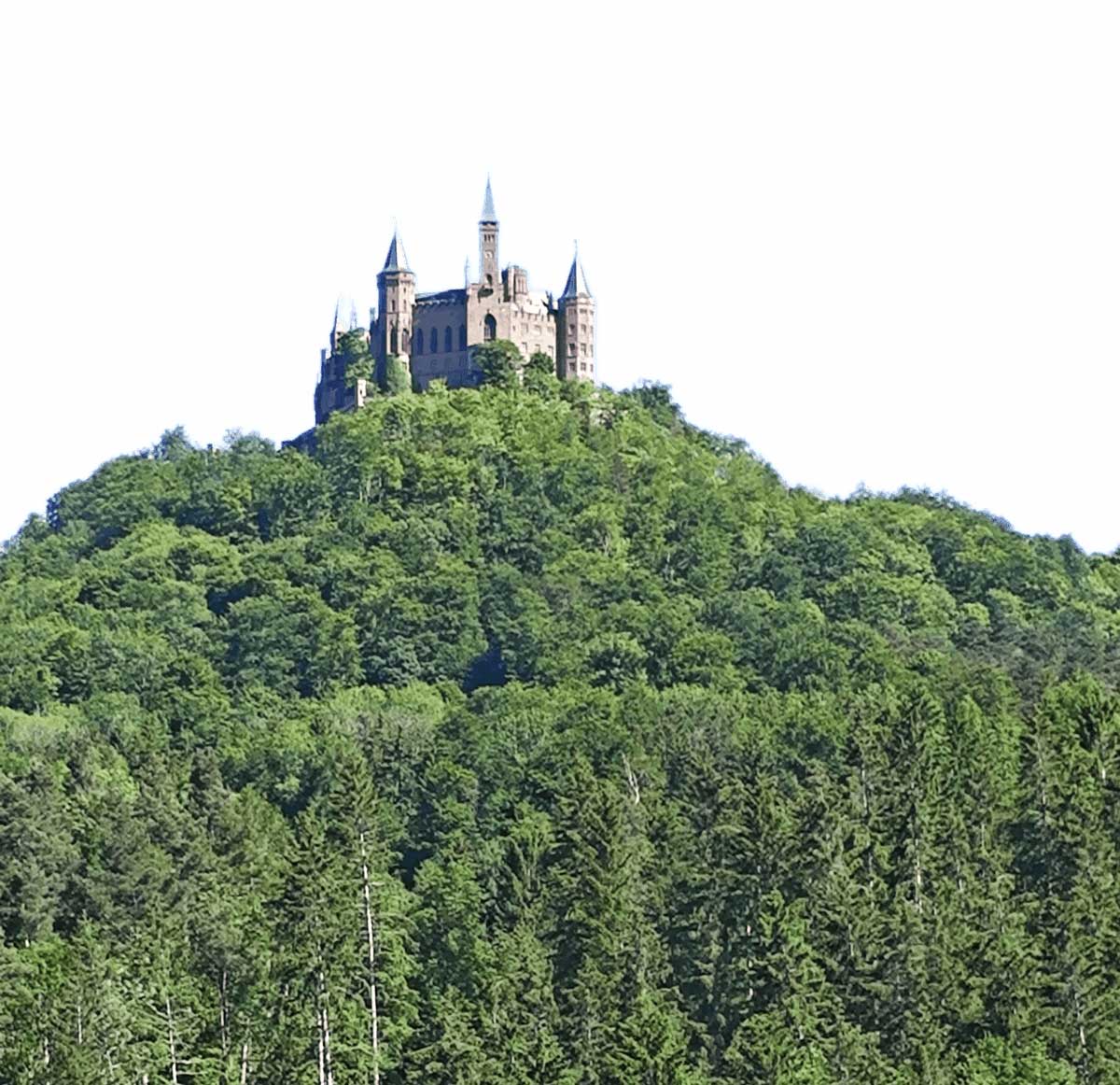
Day 12. The Neckar Valley
Today’s plan included visiting four towns. The first was Esslingen am Neckar. Stretched along the Neckar between the river and vineyard-covered hills, Esslingen is the wine-making center of the region, the result being numerous wine shops offering tastings and the queue at one establishment for a glass of white wine – clearly some local hit.

I wanted to join that line too, since white wine is my thing, but the queue was long, time was short, so I moved on. A pity, really – such things are worth experiencing. The town is full of beautiful half-timbered houses (the old town hall above all), and the unusual Gothic St. Dionysius Church of the 13th century with two towers connected by a bridge. There were plenty of tourists, but no crowds – everything felt calm.
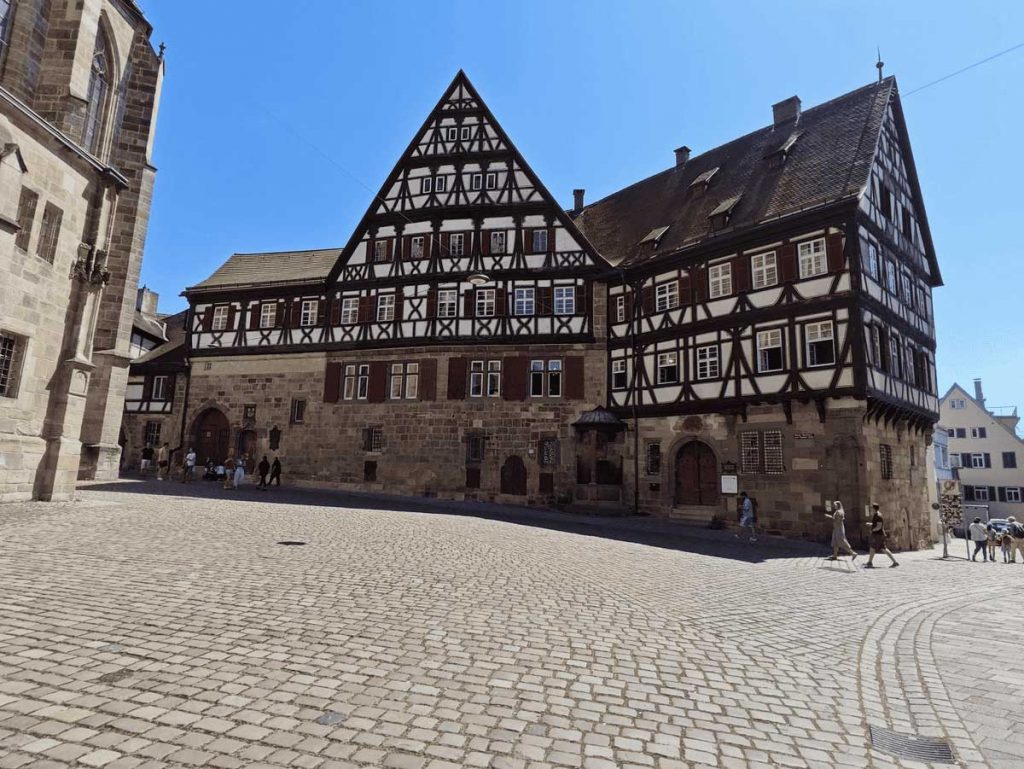
Now, in the evening, I cannot understand why I had not entered the church to see its 14th-century stained glass and other interesting interior features – I usually always do. Nor did I go to the “Little Venice” (Kleine Venedig), where the Neckar’s branches resemble Venetian canals. There you’ll also find a bridge built in the late 13th century, the second oldest in Germany, and a dam built in the form of a covered bridge. My parking time was up, I couldn’t extend it, so I left. But I did stop by the Saturday market – berries and cheese, a must.
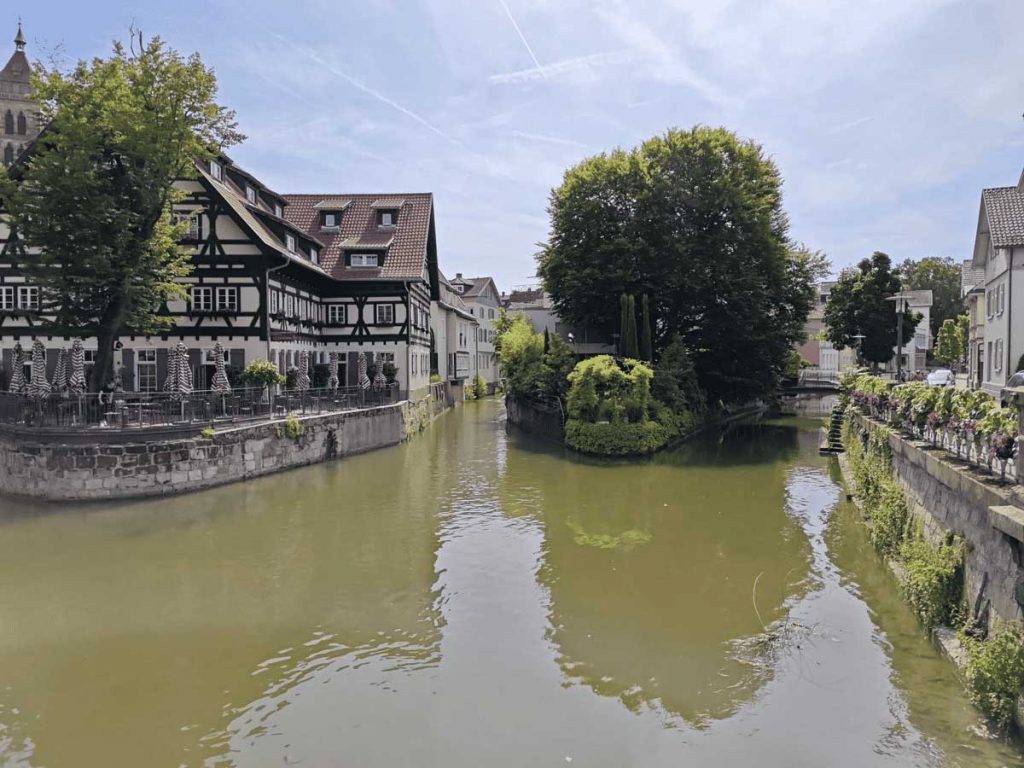
The next town, Plochingen, is also in the Neckar Valley. It’s small, with only a few half-timbered houses, but it has a building designed by Hundertwasser – and as his fan, I simply had to see it.
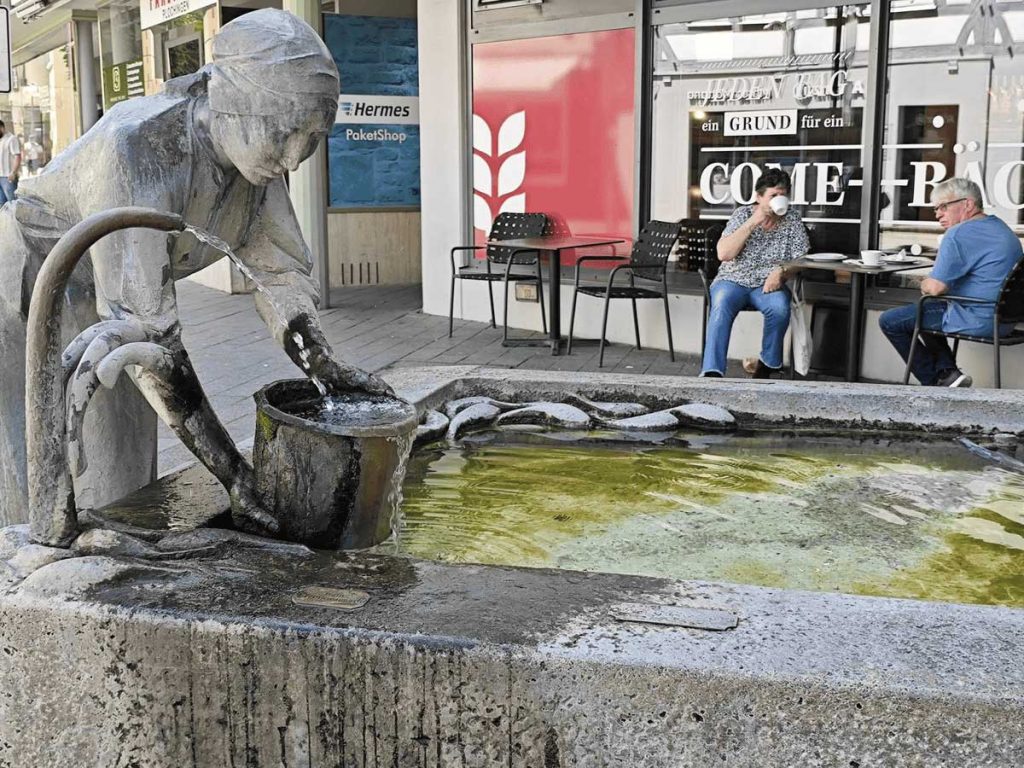
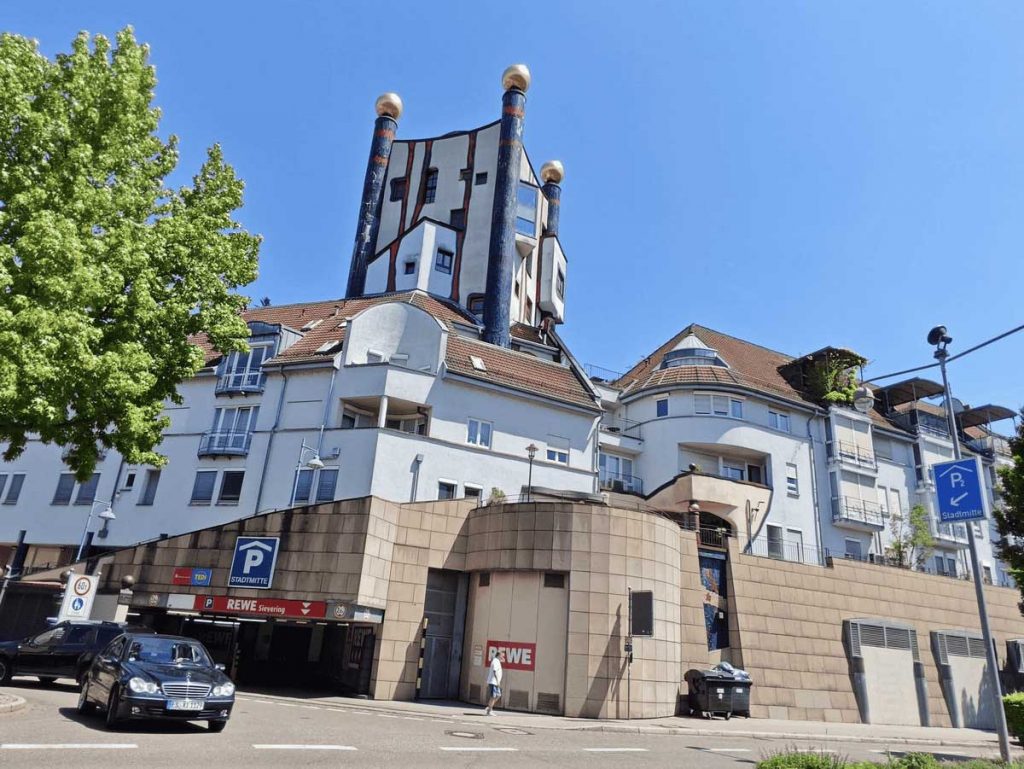
Then came Reutlingen, a fairly large city with a big old town, though scattered and not very interesting. Still, a couple of gates and the old town hall are quite nice.
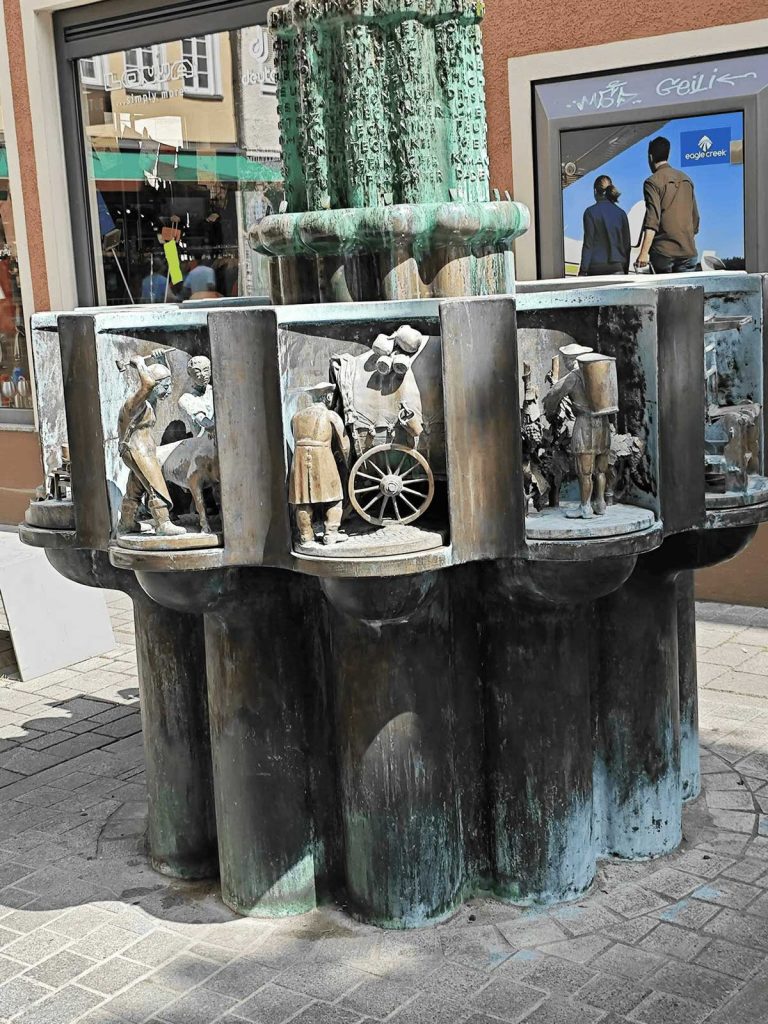
Next was Tübingen. By then I was too exhausted from the day’s heat (30 degrees with humidity) to walk much, so I drove closer to the main square of the old town, the Marktplatz, parked the car, and quickly ran over to take some shots. And there stood a town hall like none I had seen before: a huge half-timbered building with stunning paintings on its facade.
I took some photos, but unfortunately no video of Tübingen – it just didn’t record. Overall, I’d give myself a weak C for this day. My only excuse is that I left very late – at 10:30 – because of some issues. And in the evening, I received from Memmingen a newspaper photo of the “March of Life” I had participated in.

Day 13. From the Neckar to the Main – Part 1
Leaving early, I decided to return to Tübingen to see more, since it was close by. Sunday, so parking was easier. This time the huge old town hall allowed itself to be photographed. After having my first espresso of the day in a just opened café (and a very good one; the coffee situation in Germany has changed drastically since I had been here 30 years ago, when you had to search for an Italian place to have a decent coffee), I set off on my way.
And then I thought: why not also swing by Esslingen, since I hadn’t finished there. Said and done. And it turned out to be a big mistake. The so-called “Little Switzerland” was nothing special to see, no wonder there are no signs for it in the city. At least I visited the chirch.
As I was getting into the car, I was by two policemen: “An hour ago you tried to park over there and touched another car, didn’t you?” “That’s true,” I said, “but there was had to call the police. People saw and reported it to us.” “I didn’t know,” I replied. “Ignorance of the law does not exempt you from responsibility for breaking it. And when you drive somewhere, you must familiarize yourself with the driving rules of that country. Right now you are a criminal offender, and we are detaining you.” They took my documents, including my international license (ahem, to those who say they never need them!), and went to the “scene of the crime.” He pointed out a tiny, barely visible scuff on that car. “That can’t be my doing, it’s on the outer side of the bumper,” I said. We proceded to the station.
The policeman called the prosecutor’s office and explained the situation. He spent a long time filling out various forms. “Don’t worry,” he said, “most likely the prosecutor won’t issue a fine, the damage is really minimal and not necessarily your fault. But here’s another letter; give it to Avis when you return the car, they’ll have to contact the car’s owner, find out if he demands compensation, and then report back to me.” That’s how it’s done here, and that’s how I paid the price for not realizing that the rental car was larger than mine and won’t fit. Now everything depends on the prosecutor and the car owner. (I write these lines almost thee months after the incident; meanwile, no news.)
Starting at last on today’s program, I drove to Calw, a small town that was deserted due to Sunday, with yet another row of half-timbered houses. They stood in a continuous line, which enhanced the impression.
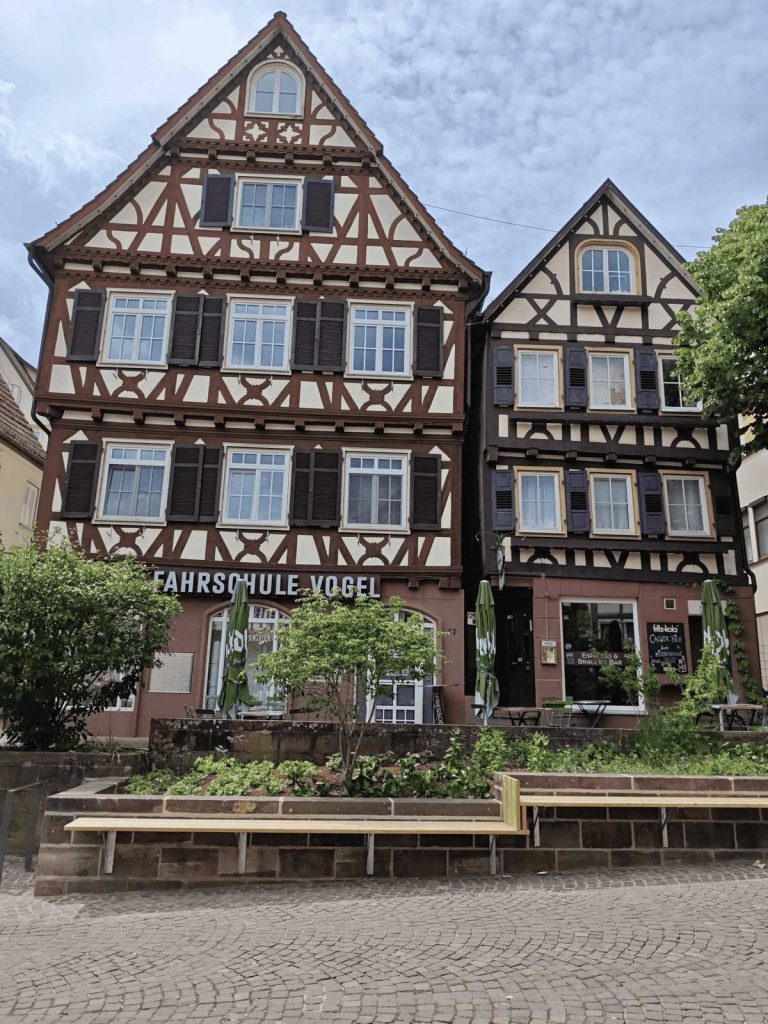
Next came Pforzheim, where a beautiful modern district has been built on the site of the old town destroyed in the war. As a big fan of modern architecture, I really enjoyed having a walk there for a change. The city also has a 1903 tower with Art Nouveau stained glass, but it appeareed to be under restoration and completely covered in scaffolding.
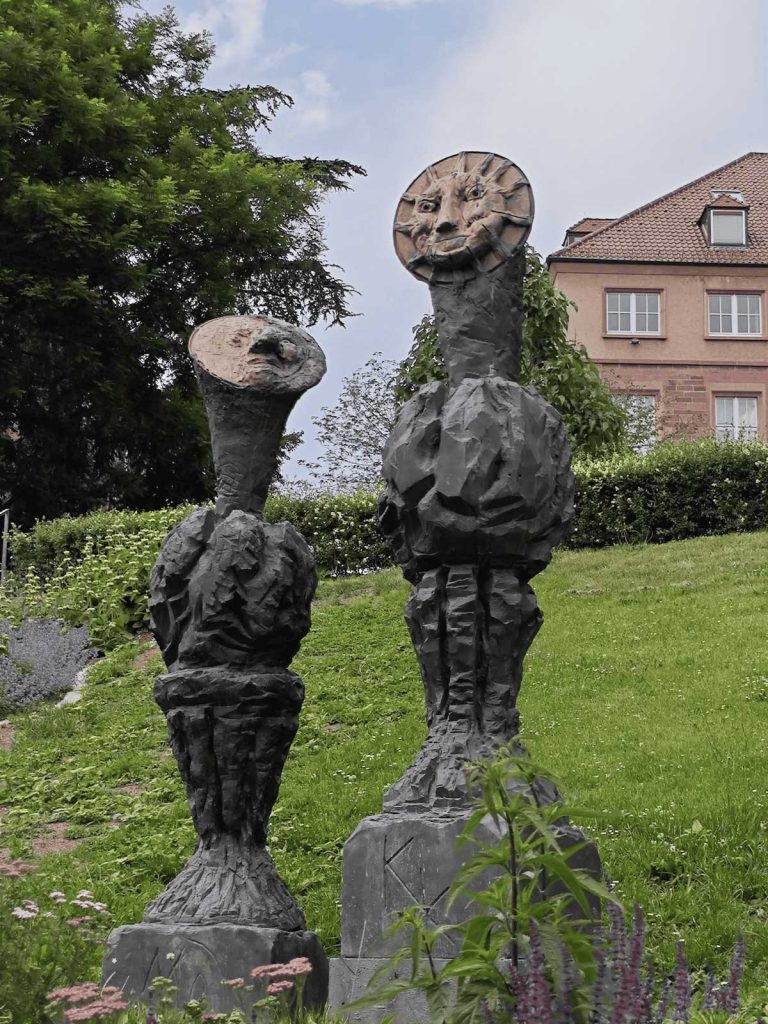
I also went to the Gasometer, a huge gas holder made of shiny metal, where the German artist of Iranian origin Yadegar Asisi creates giant panoramic images (32 m high and 110 m in circumference) on various themes. They are based on his photos and paintings, and are projected onto the walls. At the moment, “Amazonia” is on display. Very colorful, with birdsong, but it could have been skipped, more for children, perhaps.
The Maulbronn Monastery, a UNESCO World Heritage site which I visited afterwards, began construction at the end of the 12th century. It is one of the first Gothic structures in the German world. In the monastery church there is very interesting stone and wood carving. The half-timbered houses of the town of Maulbronn itself are also very photogenic.
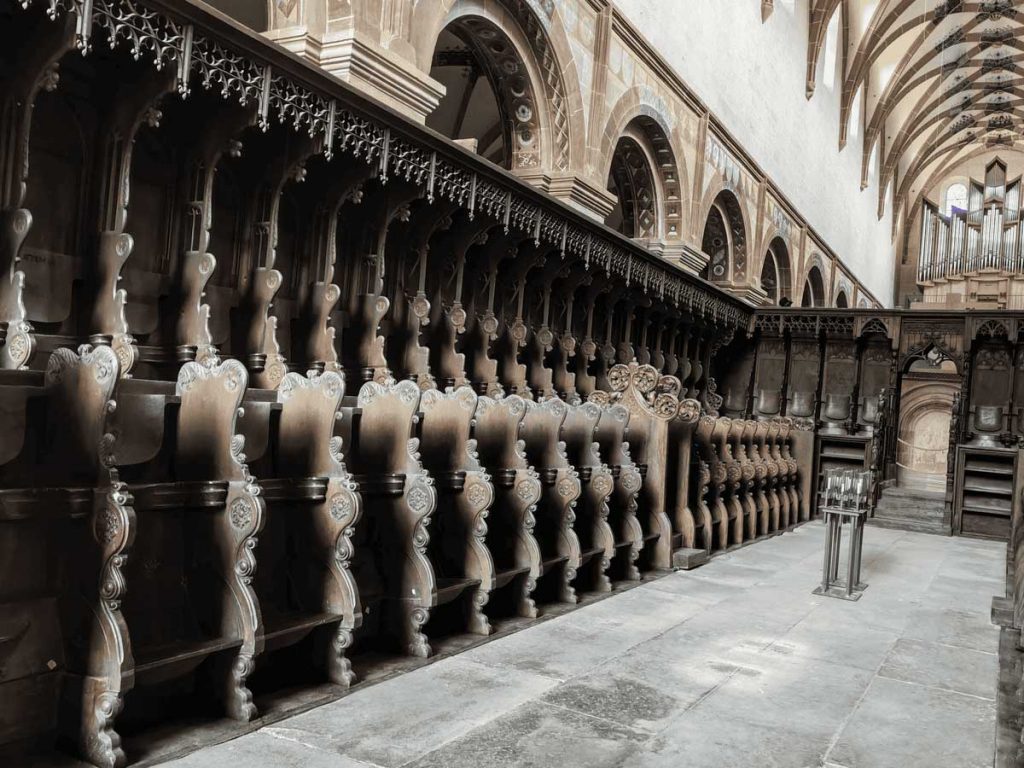
On the way to Heidelberg for the overnight I stopped by in Speyer to have a look at its Romanesque cathedral, one of the three great Romanesque cathedrals of Germany. I have been here before; this time I was less impressed as it felt a bit heavy. But it is really large. The city also has a Jewish museum with remains of Jewish community buildings from the 12th–14th centuries, including one of the oldest mikvehs in Europe, but I was too late, it was open only until 17:00 (16:00 on weekdays).

Day 14. From the Neckar to the Main – 2
After the previous night in a shabby Turkish guesthouse, this one was great in a 3-star hotel in Heidelberg. And with a good breakfast offering about ten different cheeses, all very tasty. But in the city garage, despite the sign saying the maximum cost is €20, the machine charged me €30, and I had to pay. Unpleasant, but not fatal.
Being anyway in Heidelberg, I decided to drive up to the castlewhere I had been many years ago. I drove up the hill, but just before the castle the road was blocked, so I photographed some castle-like building and advanced on my way. I decided make a small detour to Worms to see once again it’s 12th-century Romanesque cathedral, the smallest of the three so-called Imperial Cathedrals on the Rhine – here, in Speyer, and in Mainz.
The Romanesque façade of the cathedral facing the city is very beautiful, unfortunately partially hidden by a houses built almost flush against it. The interior is Gothic, while the entire “furnishing” of the main apse (which strangely is located behind the main façade without the usual external projection) and the pulpit are Baroque. Huge high reliefs on biblical themes adorn the walls.
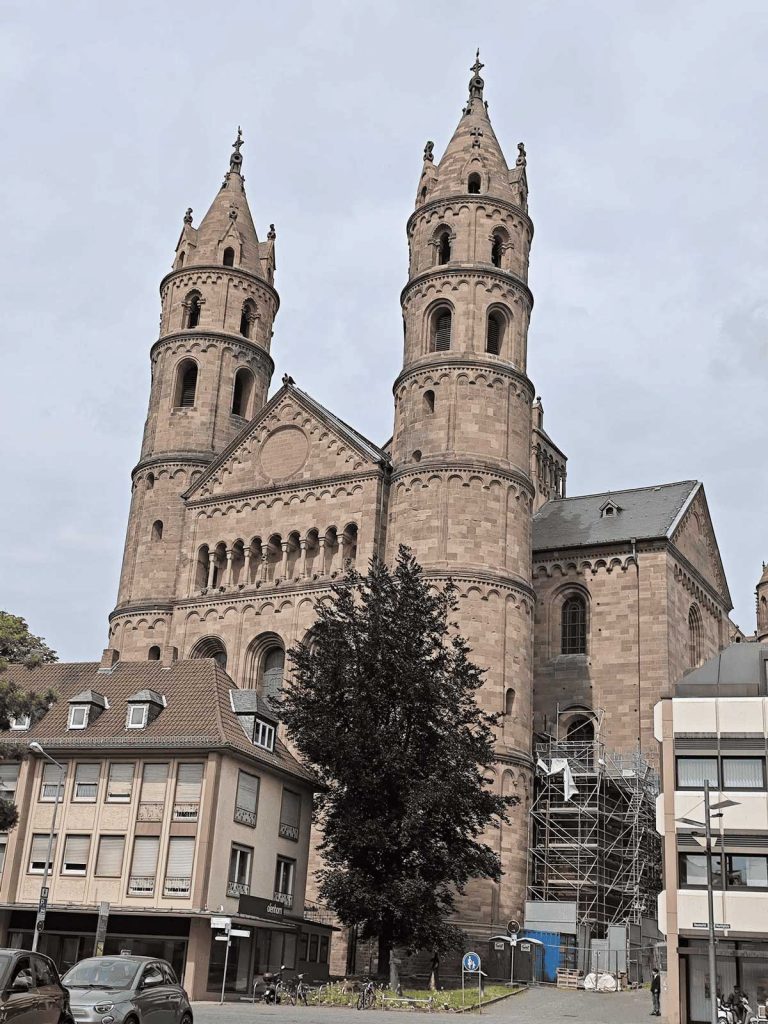
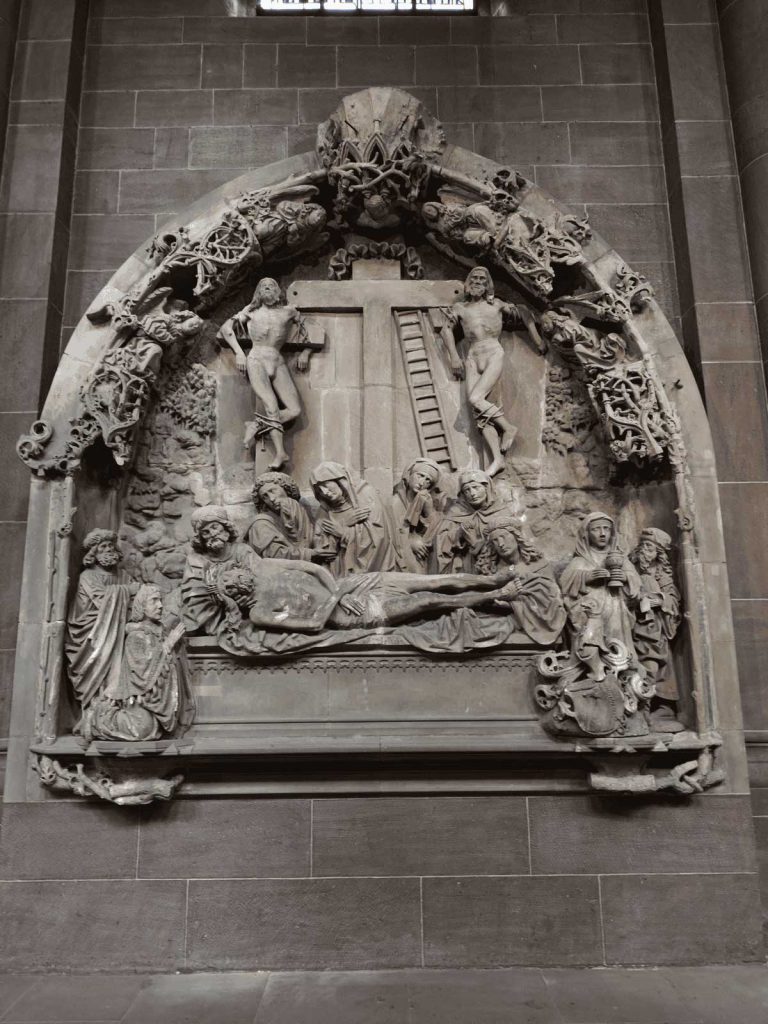
From the cathedral I went to the Worms Synagogue, or Rashi Synagogue, one of the oldest in Germany. After thorough restoration it became active again and is open to visitors. Built in 1034, the synagogue was soon destroyed in 1096 during pogroms and rebuilt almost a hundred years later.
Next was the Lorsch Monastery. Here a structure from the early 9th century has been preserved, either a gatehouse with rooms above, or a guardhouse with gates below. This structure of colored bricks is a beautiful example of pre-Romanesque Carolingian architecture with Roman elements.
Its purpose is unclear, and in the literature it is also called the King’s Hall, after Charlemagne, under whom it was built. For some reason, looking at this relic from the depth of time was moving, something I hadn’t felt even with much older structures. (Well, the Sphinx was an exception, but that’s the Sphinx.) Nearby there is another structure of a much similar type, but I could’nt find anything about it anywhere .
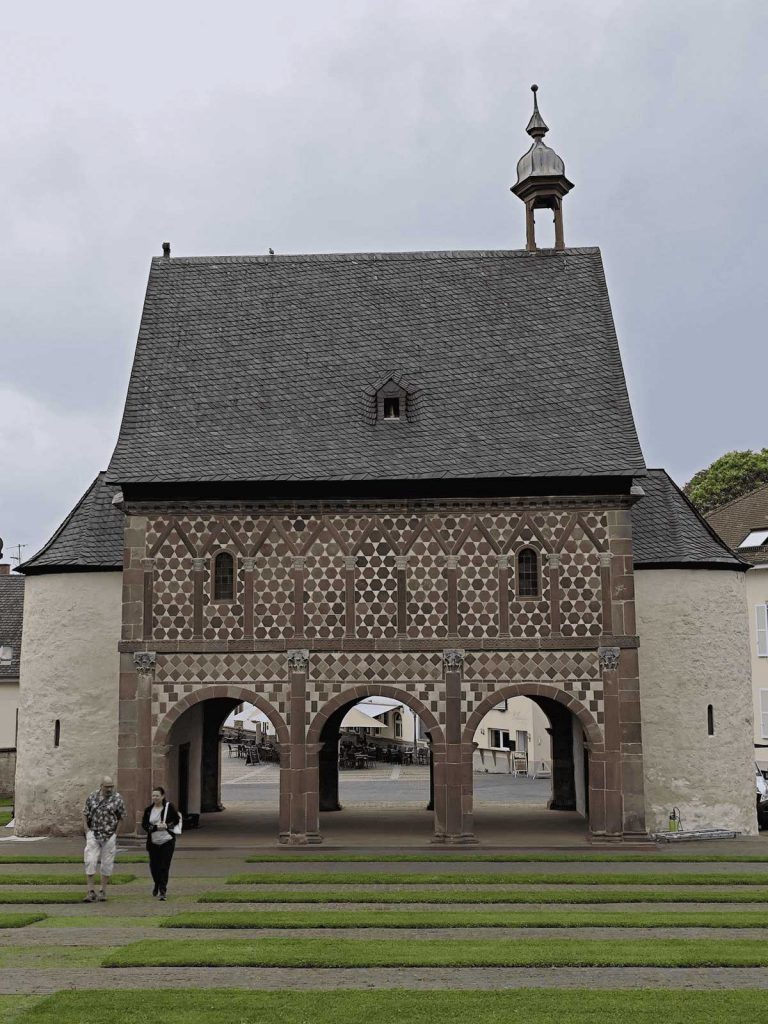
My further path went through the town of Heppenheim an der Bergstrasse. It had been in my plans, but I decided to skip it. However, from the streets perpendicular to the road, it sent me signals, and I realized I had to stop there. I made a U-turn, drove into the town, entered the Church of St. Peter (called the “Cathedral of the Bergstrasse”), disproportionately large for such a small town, and was stunned.
Full of bright stained glass, with rose windows in the transept, and a series of 13 high reliefs depicting the the Way of the Cross. This was a high point I’ve been missing on this trip, everything being nice but rather monotonous. And the whole town felt very “authentic,” with its old town hall on the central square and a ring of half-timbered houses around it. May be the reason was the absence of tourists. What luck that I didn’t just drive past.

The last town of the day was Miltenberg. It stands on the third great river of my journey, the Main, with large riverboats waiting for tourists. It has its share of half-timbered houses and a beautiful tower on the Würzburg Gate. One of the houses has a plaque: “Old Synagogue (1791–1900). The new one (1900–1938) was located…” That says it all.
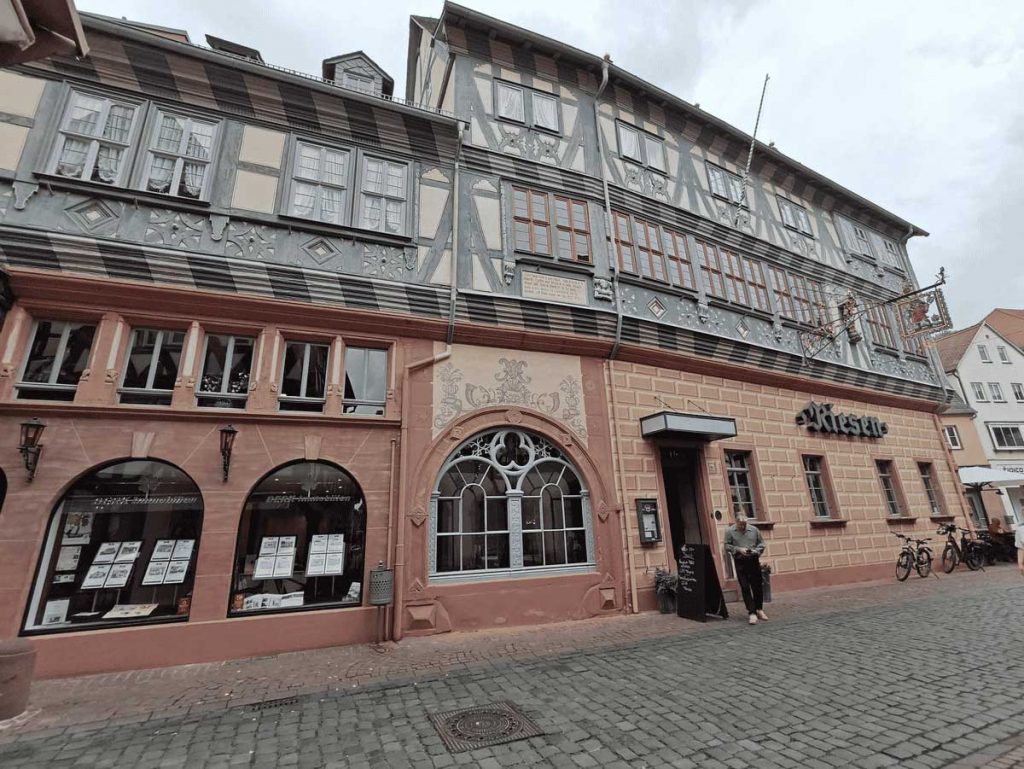
Another tower stands at the entrance to the bridge over the Main. When on the bridge, you can see large, romantic-looking castle-like buildings on the slopes above the town. A beautiful place!
Day 15. From the Neckar to the Main – 3
On a clear sunny morning, I drove to Mespelbrunn Castle. The road winds through a dense mixed forest, with the tree canopies sometimes closing overhead. The castle sits in a hollow on the shore of a small pond, and is surrounded by forest. It is small and beautiful, with a round tower.
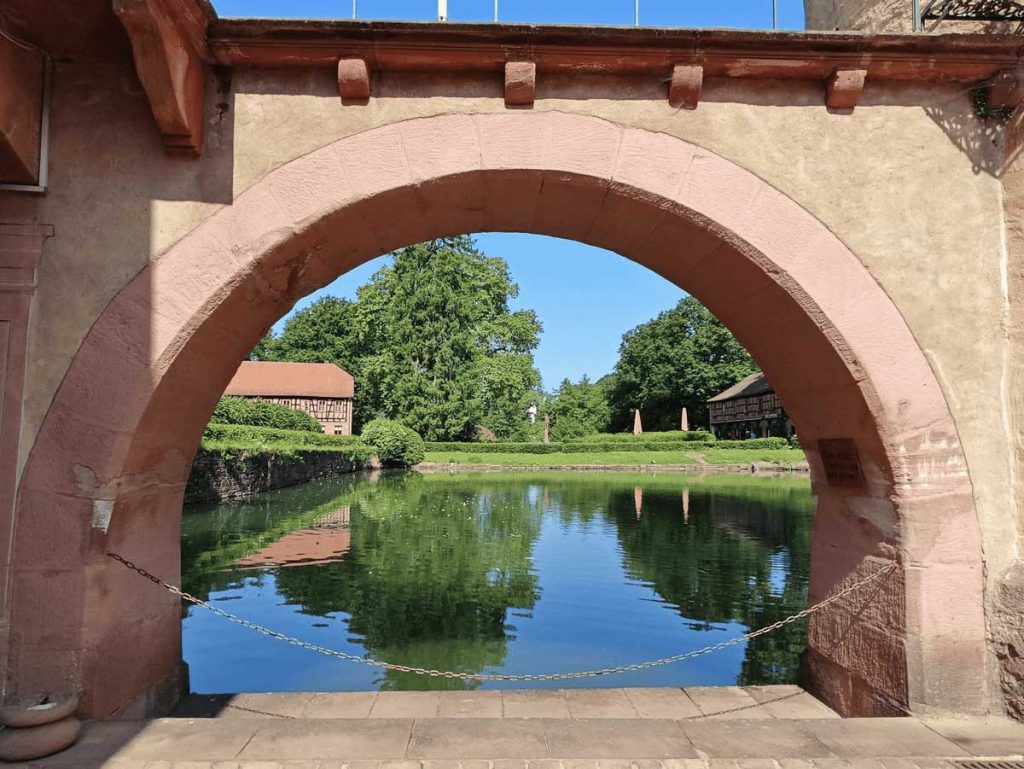
You can only enter with a guided tour, which I would have had to wait for, so I took some photos in the yard and then drove to Darmstadt. This city wasonce a center of Art Nouveau, known in Germany as Jugendstil. From that period, a number of interesting buildings remain, especially on the Mathildenhöhe (Mathilda’s Hill): the “Wedding Tower” (Hochzeitsturm), also called the “Five-Finger Tower”; the Artists’ Colony Museum (Museum Künstlerkolonie); villas in the Art Nouveau style built by the architects who lived and worked in Darmstadt; and the Russian Chapel. The chapel was built between 1897 and 1899 on soil brought from Russia in an eclectic Russian style, designed by Leon Benois and commissioned by the last Russian emperor Nicholas II. The Mathildenhöhe area is lovely, on the edge of a park, quiet, with birds singing.
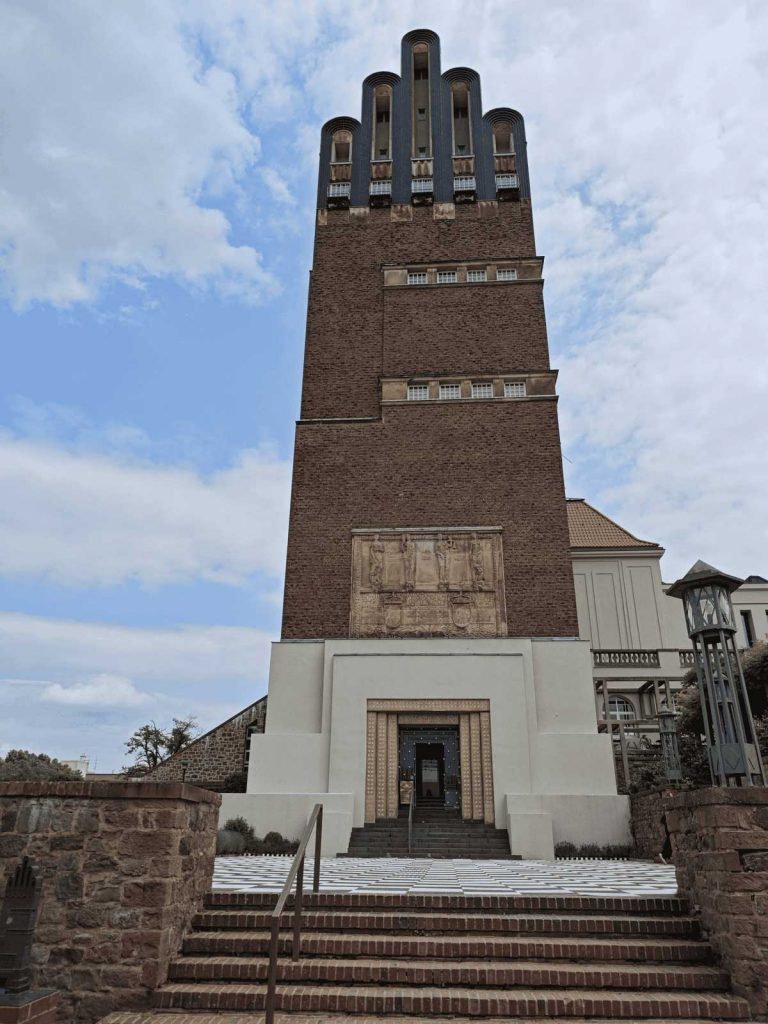

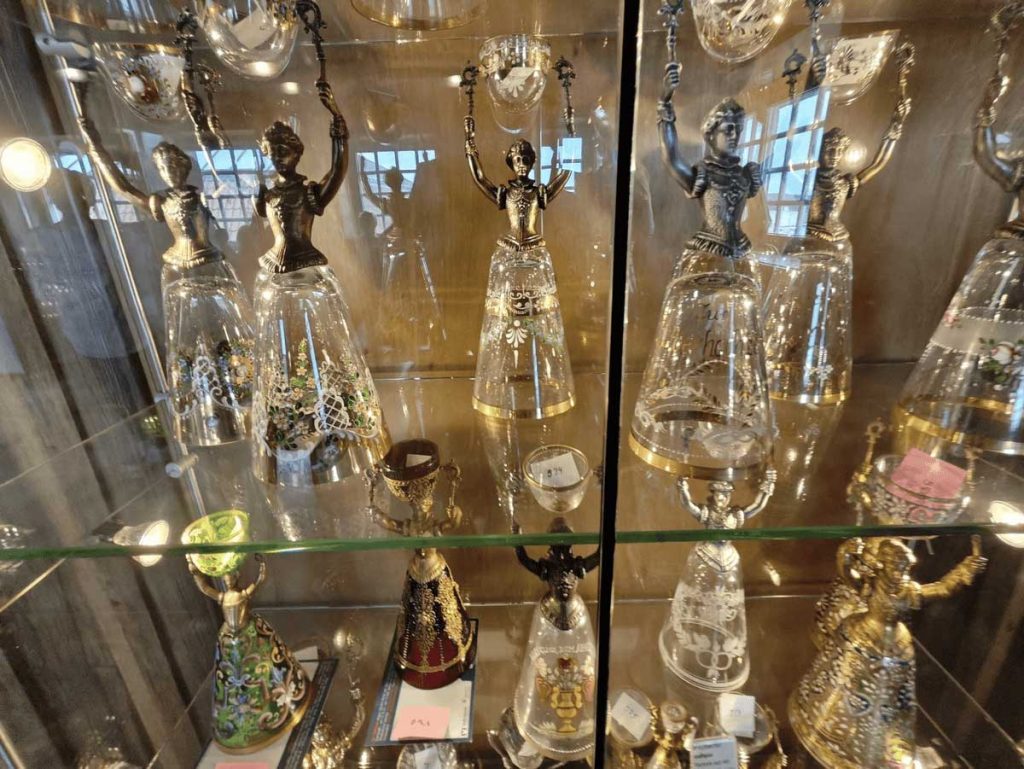
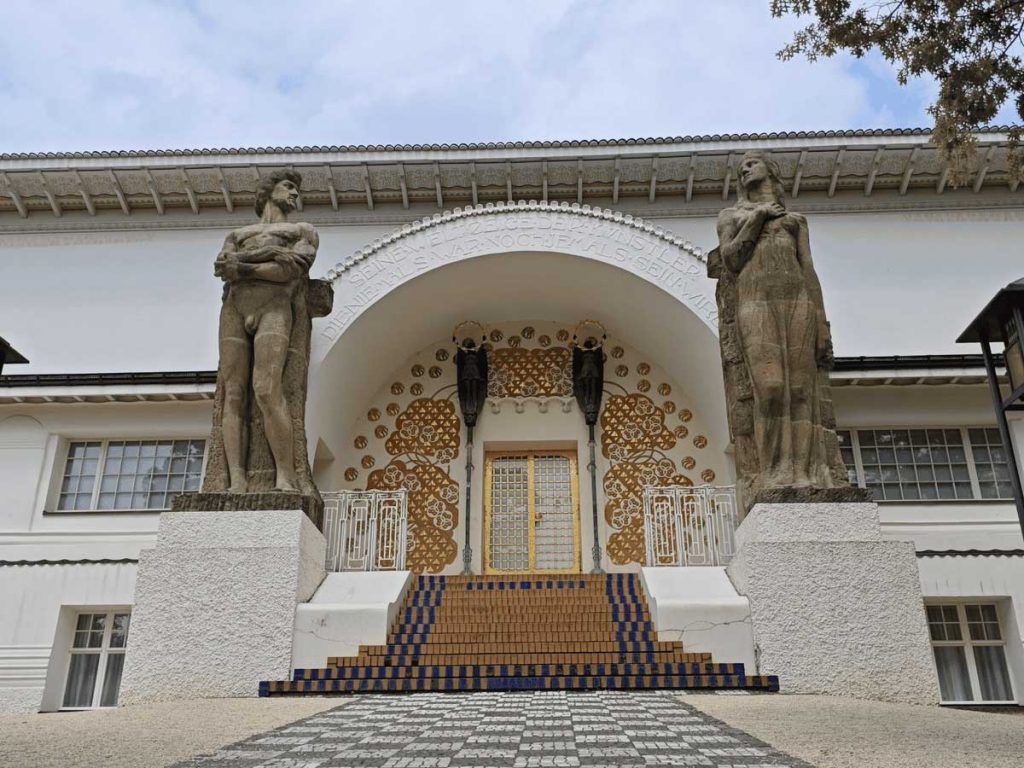
On the city’s central square, Luisenplatz, stands a 33-meter-high column with a statue of Ludwig I, Grand Duke of Hesse. I didn’t like much the city’s center: lots of heavy “German” buildings, few interesting ones, though there are some standing out. But the Art Nouveau heritage makes up for it. And when you add to it the “Forest Spiral” (Waldspirale), a huge residential complex designed by Hundertwasser, it becomes clear: Darmstadt is well worth a visit.
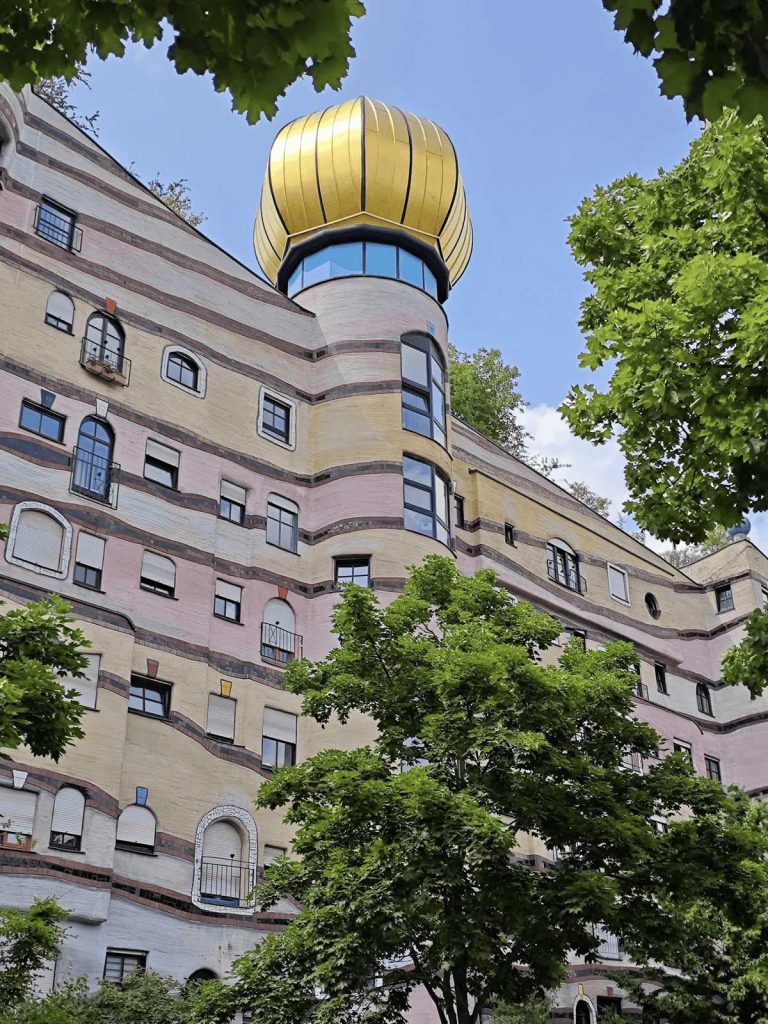
Day 16. Mainz and Frankfurt
Today was definitely an anticlimax: calm, unhurried, the closing day of the trip. I have been to both cities before, but since it was long ago and they were actually on my way, I stopped by both again. In the morning, under a light drizzle, I went to Mainz to see the third great German cathedral.
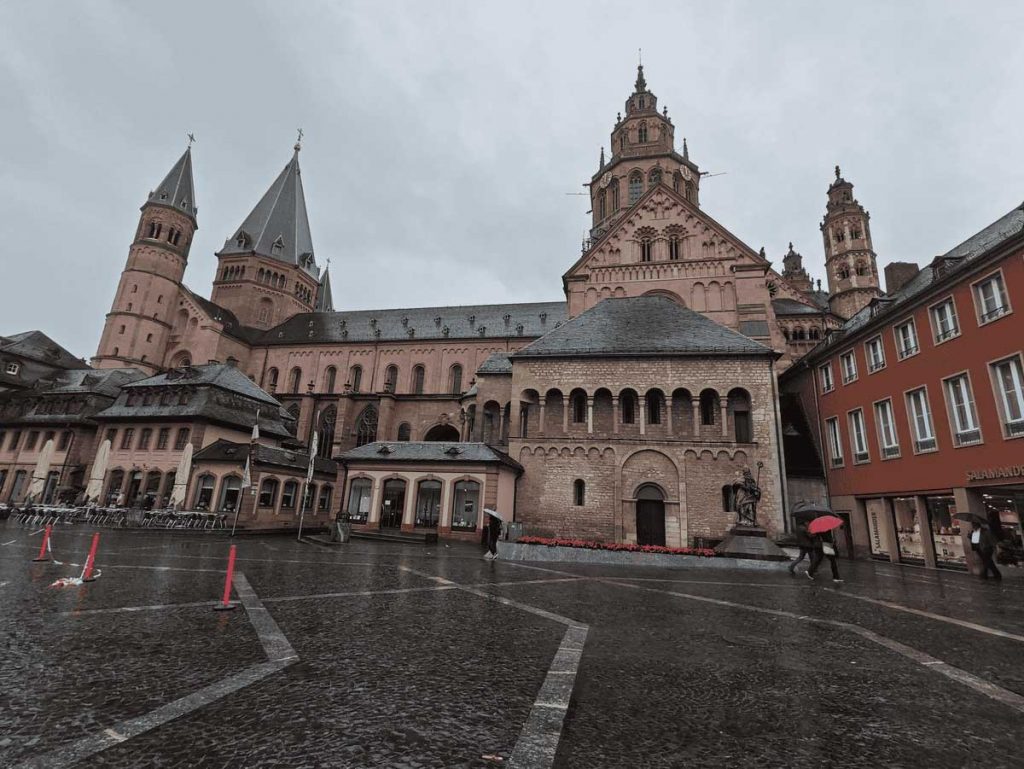
This time all three cathedrals impressed me less. After all, in the last 30 years I’ve seen quite a lot. But for those visiting these places for the first time all of them are a must. In Frankfurt, I happily returned to the famous central square of the old town with its row of wonderful half-timbered houses, the most famous of which is the old town hall. I walked up to the bridge over the Main River, which offers a good view of the city, including the modernist glass-and-concrete towers of the financial district.

I must admit here that although I’ve really enjoyed dozens, if not hundreds, half-timbered houses in Germany, I still prefer those in France, such as, say, in the city of Troyes.
Between the two cities, I stopped in the spa town of Bad Soden to see another Hundertwasser building, much smaller than the one in Darmstadt, cozier, surrounded by greenery, and charming. Here, Hundertwasser wasn’t trying so hard to avoid straight lines, no twisted windows, more subdued, almost like a toy. With this building, I nearly completed my tour of this unique architect’s works. There are still a couple more in northern Germany. Maybe I’ll see them one day. For now, tomorrow it’s back home and everyday life.
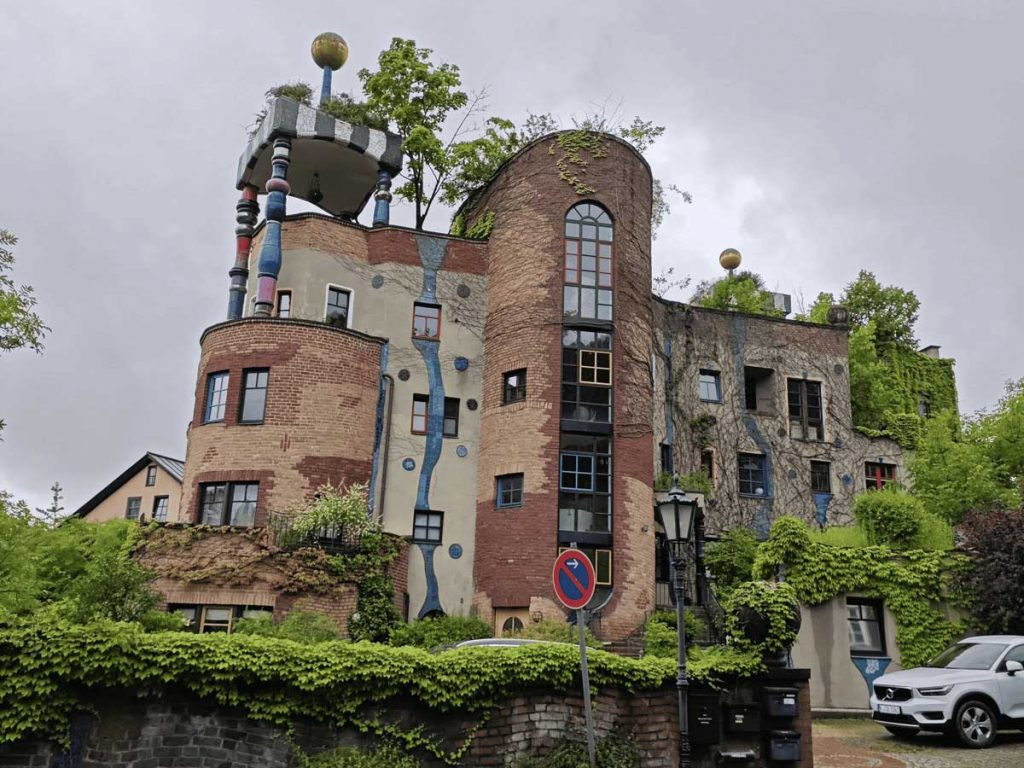
Germany and a Little Bit of Austria – Summary
This trip could be shortened by two or three days, leaving time to include Salzburg and the Grossglockner Alpine Road with its glacier. Though the Salzkammergut is worth a separate, more detailed visit. Other Ludwig castles, Linderhof and Neuschwanstein, could also be added as they are close by.
I must say my impressions during this trip were different from those in the Iberian Peninsula. Even in its most famous places, Spain and Portugal didn’t feel as “over-touristed” as some spots here, nor did I encounter food as poor as I sometimes found in Germany. I was surprised by Germans’ way of driving (or were they Germans? There is an incredible number of immigrants here). Cars ran red lights, even at pedestrian crossings. Twice I was dangerously cut off.
It was also strange that street names were rarely marked on houses or even intersections. Maybe I forgot things in the 30 years since I last visited Germany. Twice I had problems with Turkish-owned hotels. I was also struck by the enormous number of Italian restaurants and pizzerias; in Innsbruck, street signs were even bilingual, though the city isn’t that close to Italy.
Still, I plan to continue to travel in Germany: from Frankfurt north to Denmark (I’ve only been to Hamburg, Bremen, and Lübeck in this part of the country), then east across Germany, and down to Berlin. Then further south, including Wernigerode and other famous “half-timbered towns”, down to the Danube and then to Munich. Hope to make it some day.

